
S&P 500
Downwards movement was expected as most likely for Friday’s session, which is exactly what happened.
The first target at two degrees can now be calculated.
Summary: The low of December 2018 is expected to most likely remain intact, and this pullback is expected to be followed by a strong third wave up to new all time highs.
A pullback may end next week. The first target is now at 2,738 to 2,739, which has a good probability.
The second target is about 2,722 and may see price find support about the lower edge of the black Elliott channel.
If price keeps falling through these targets, then a classic target calculated from the pennant pattern is about 2,690. This target looks too low.
The alternate wave count considers the possibility that a relatively short lived bear market may have begun. The target is at 2,080. This wave count has a fairly low probability, but it is a possibility that must be acknowledged.
The biggest picture, Grand Super Cycle analysis, is here.
Monthly charts were last published here, with video here. There are two further alternate monthly charts here. Video is here.
ELLIOTT WAVE COUNTS
The first two Elliott wave counts below will be labelled First and Second. They may be about of even probability. When the fifth wave currently unfolding on weekly charts may be complete, then these two wave counts will diverge on the severity of the expected following bear market. To see an illustration of this future divergence monthly charts should be viewed.
The alternate Elliott wave count has a very low probability.
FIRST WAVE COUNT
WEEKLY CHART
The basic Elliott wave structure consists of a five wave structure up followed by a three wave structure down (for a bull market). This wave count sees the bull market beginning in March 2009 as an incomplete five wave impulse and now within the last fifth wave, which is labelled cycle wave V. This impulse is best viewed on monthly charts. The weekly chart focusses on the end of it.
Elliott wave is fractal. This fifth wave labelled cycle wave V may end a larger fifth wave labelled Super Cycle wave (V), which may end a larger first wave labelled Grand Super Cycle wave I.
The teal Elliott channel is drawn using Elliott’s first technique about the impulse of Super Cycle wave (V). Draw the first trend line from the end of cycle wave I (off to the left of the chart, the weekly candlestick beginning 30th November 2014) to the end of cycle wave III, then place a parallel copy on the end of cycle wave II. This channel perfectly shows where cycle wave IV ended at support. The strongest portion of cycle wave III, the end of primary wave 3, overshoots the upper edge of the channel. This is a typical look for a third wave and suggests the channel is drawn correctly and the way the impulse is counted is correct.
Within Super Cycle wave (V), cycle wave III is shorter than cycle wave I. A core Elliott wave rule states that a third wave may never be the shortest. For this rule to be met in this instance, cycle wave V may not be longer in length than cycle wave III. This limit is at 3,477.39.
A final target is calculated at cycle degree for the impulse to end.
The structure of cycle wave V is focussed on at the daily chart level below.
Within cycle wave V, primary wave 2 may not move beyond the start of primary wave 1 below 2,346.58.
In historic analysis, two further monthly charts have been published that do not have a limit to upwards movement and are more bullish than this wave count. Members are encouraged to consider those possibilities (links below summary) alongside the wave counts presented on a daily and weekly basis.
DAILY CHART
Cycle wave V must subdivide as a five wave motive structure. Within that five wave structure, primary wave 1 may be complete. Primary wave 2 may now continue lower as a zigzag, which may end next week.
Primary wave 3 must move above the end of primary wave 1.
When primary wave 3 is over, then primary wave 4 may be a shallow sideways consolidation that may not move into primary wave 1 price territory below 2,954.13.
Thereafter, primary wave 5 should move above the end of primary wave 3 to avoid a truncation.
Primary wave 2 may not move beyond the start of primary wave 1 below 2,346.58.
Draw a channel about primary wave 2 using Elliott’s technique. Draw the first trend line from the start of intermediate wave (A) to the end of intermediate wave (B), then place a parallel copy on the end of intermediate wave (A). Intermediate wave (C) may end when price finds support at the lower edge of this channel.
When the channel is breached by upwards movement, it shall be used as an indication that the pullback for primary wave 2 is over and primary wave 3 would then be expected to be underway.
SECOND WAVE COUNT
WEEKLY CHART
This weekly chart is almost identical to the first weekly chart, with the sole exception being the degree of labelling.
This weekly chart moves the degree of labelling for the impulse beginning in March 2009 all down one degree. This difference is best viewed on monthly charts.
The impulse is still viewed as nearing an end; a fifth wave is still seen as needing to complete higher. This wave count labels it primary wave 5.
ALTERNATE WAVE COUNT
WEEKLY CHART
It is possible that for the second wave count cycle wave I could be complete. Primary wave 5 may be seen as a complete five wave impulse on the daily chart.
If cycle wave I is complete, then cycle wave II may meet the definition of a bear market with a 20% drop in price at its end.
Within cycle wave I, primary wave 1 was a very long extension and primary wave 3 was shorter than primary wave 1 and primary wave 5 was shorter than primary wave 3. Because primary wave 1 was a long extension cycle wave II may end within the price range of primary wave 2, which was from 2,132 to 1,810. The 0.382 retracement of cycle wave I is within this range.
Cycle wave II may not move beyond the start of cycle wave I below 666.79.
This wave count does not have support at this time from classic technical analysis.
DAILY CHART
The most likely structure for cycle wave II would be a zigzag. Within a zigzag, primary wave A would subdivide as a five wave structure, most likely an impulse. Within the impulse of primary wave A, so far intermediate waves (1) and (2) may be complete and intermediate wave (3) has moved below the end of intermediate wave (1) and may be incomplete.
Intermediate wave (3) would reach 1.618 the length of intermediate wave (1) at 2,645.
Within the zigzag, primary wave B may not move beyond the start of primary wave A.
TECHNICAL ANALYSIS
WEEKLY CHART
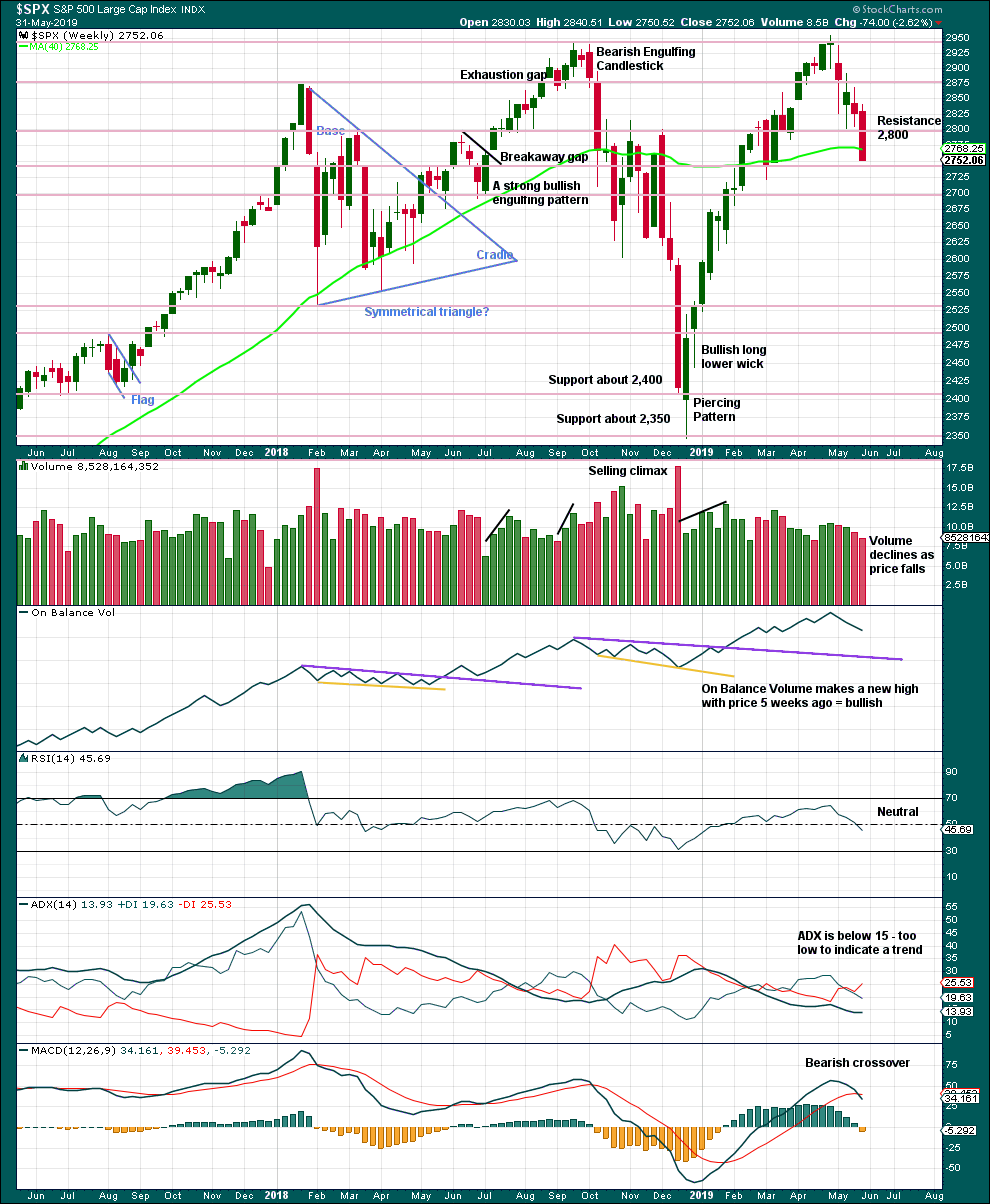
Click chart to enlarge. Chart courtesy of StockCharts.com.
There is an upwards trend from the low in December 2018, a series of higher highs and higher lows with a new all time high on the 30th of April 2019. The last swing low at 2,785.02 on the 25th of March has now been breached, so a trend change is now possible.
This weekly candlestick closes with strong downwards movement and almost no lower wick. The lack of a lower wick strongly suggests more downwards movement next week.
DAILY CHART
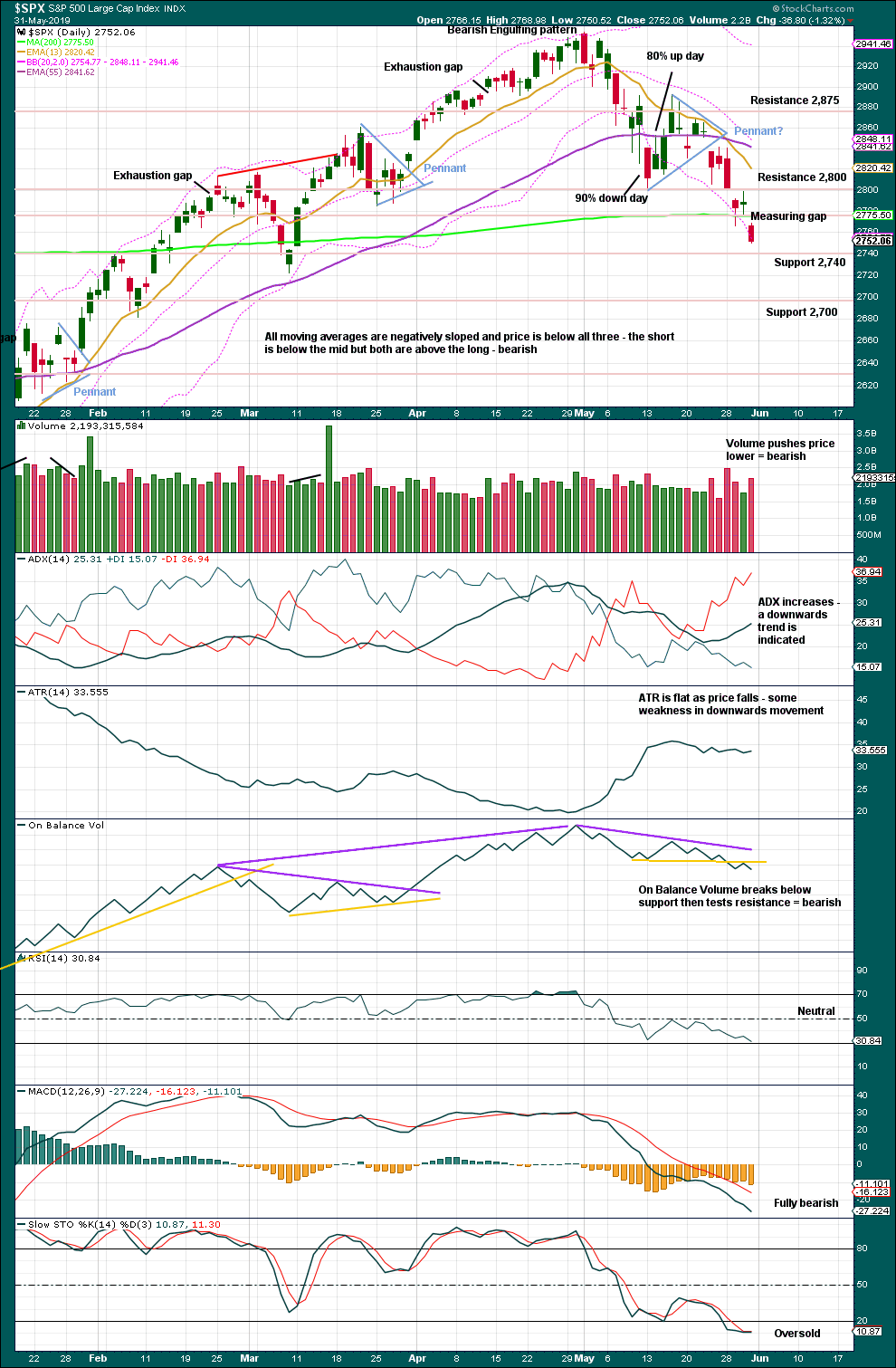
Click chart to enlarge. Chart courtesy of StockCharts.com.
A small pennant pattern may be complete and followed by a downwards breakout, which has support from volume. The target is about 2,690.
When price is trending, as it is now, Stochastics may remain extreme for a reasonable period of time. Only when Stochastics has been oversold for some time and then exhibits bullish divergence with price shall it be indicating an end to downwards movement.
Selling Pressure has assumed the dominant position over Buying Power in Lowry’s data.
Declining to flat ATR as price falls supports the first two Elliott wave counts and indicates the alternate looks less likely.
BREADTH – AD LINE
WEEKLY CHART
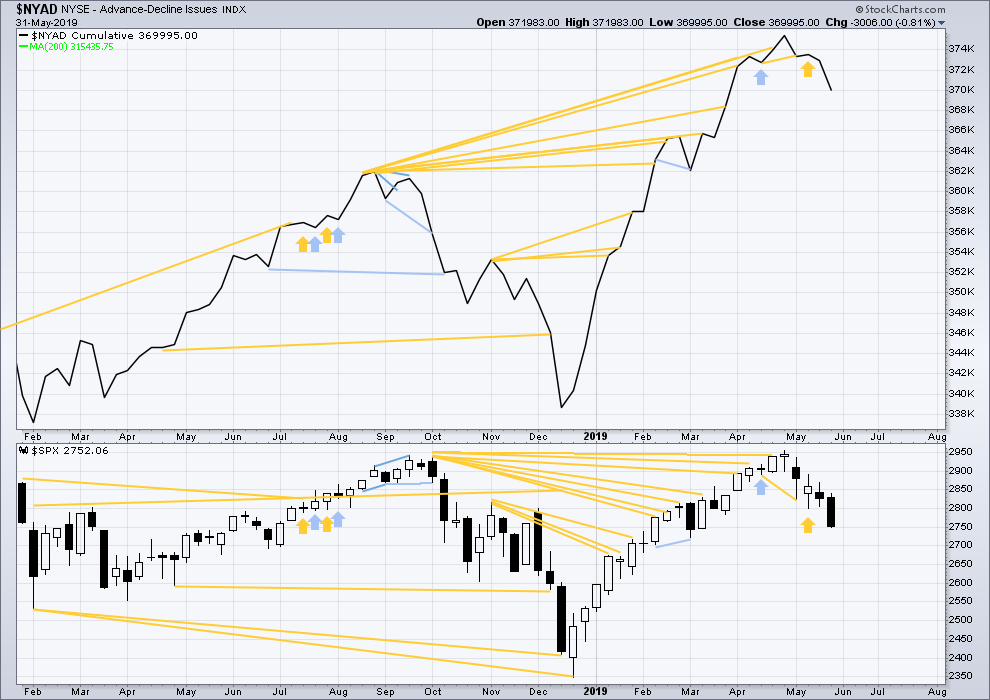
Click chart to enlarge. Chart courtesy of StockCharts.com. So that colour blind members are included, bearish signals
will be noted with blue and bullish signals with yellow.
Bear markets from the Great Depression and onwards have been preceded by an average minimum of 4 months divergence between price and the AD line with only two exceptions in 1946 and 1976. With the AD line making a new all time high on the 3rd of May, the end of this bull market and the start of a new bear market is very likely a minimum of 4 months away, which is the beginning of September 2019.
In all bear markets in the last 90 years there is some positive correlation (0.6022) between the length of bearish divergence and the depth of the following bear market. No to little divergence is correlated with more shallow bear markets. Longer divergence is correlated with deeper bear markets.
If a bear market does develop here, it comes after no bearish divergence. It would therefore more likely be shallow. The alternate Elliott wave count outlines this potential scenario.
Price has moved lower for the week. Neither price nor the AD line have made new lows below the prior swing low of the week of the 4th of March. There is no new mid-term divergence.
DAILY CHART

Click chart to enlarge. Chart courtesy of StockCharts.com. So that colour blind members are included, bearish signals
will be noted with blue and bullish signals with yellow.
Breadth should be read as a leading indicator.
Price has now made a new mid-term low below the prior low of the 25th of March, but the AD line has not. Price is falling faster than market breadth. This divergence is bullish for the mid term and supports the view that this pullback is a counter trend movement within an ongoing bull market and not the start of a fully fledged bear market.
VOLATILITY – INVERTED VIX CHART
WEEKLY CHART
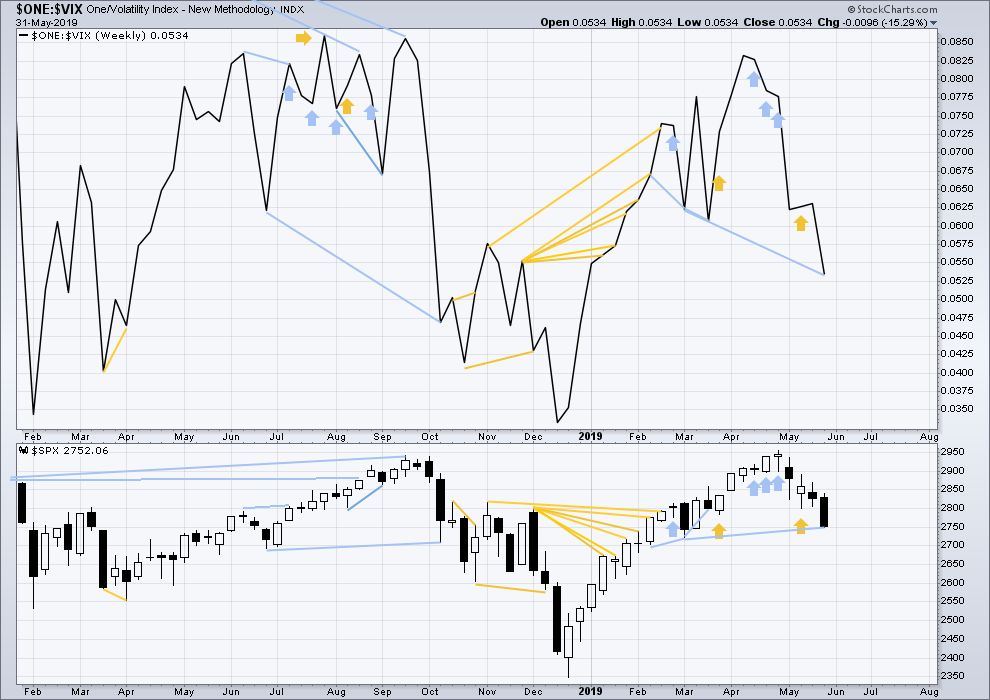
Click chart to enlarge. Chart courtesy of StockCharts.com. So that colour blind members are included, bearish signals
will be noted with blue and bullish signals with yellow.
Inverted VIX has made a new low below the low of the 4th of March, but price has not. Downwards movement comes with a strong increase in VIX, which is increasing faster than price. This divergence is bearish, but will not be given much weight in this analysis at this time.
If bearish divergence develops further, then it may be given some weight.
DAILY CHART
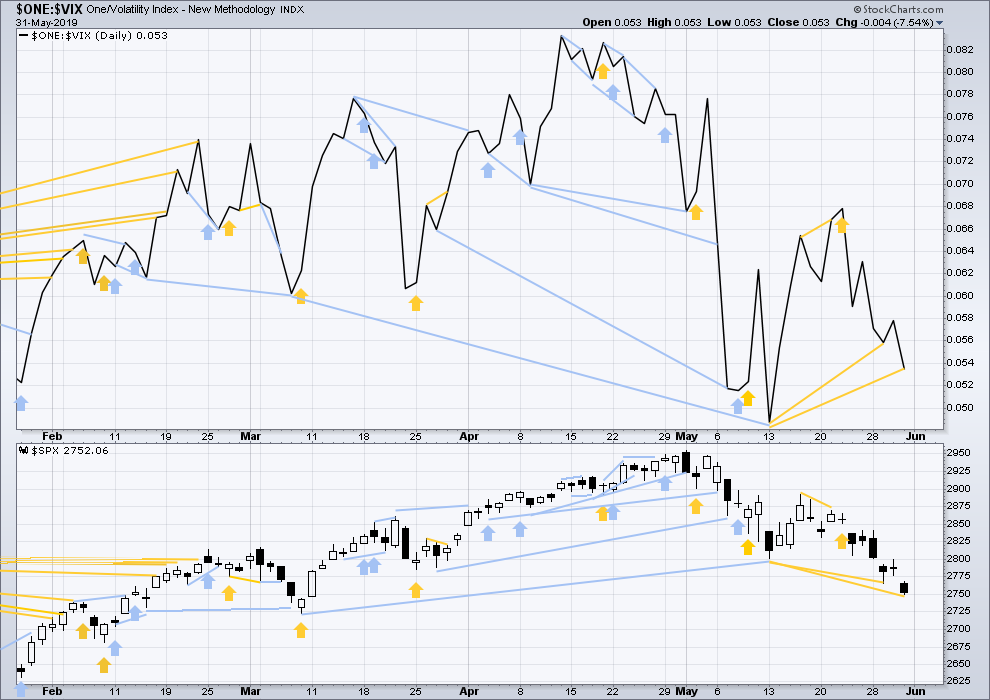
Click chart to enlarge. Chart courtesy of StockCharts.com. So that colour blind members are included, bearish signals
will be noted with blue and bullish signals with yellow.
Price has made a new low below the prior low of the 13th of May, but inverted VIX has not. For the short term, the fall in price does not come with a corresponding increase in VIX. This divergence is bullish.
DOW THEORY
Dow Theory confirmed a bear market in December 2018. This does not necessarily mean a bear market at Grand Super Cycle degree though; Dow Theory makes no comment on Elliott wave counts. On the 25th of August 2015 Dow Theory also confirmed a bear market. The Elliott wave count sees that as part of cycle wave II. After Dow Theory confirmation of a bear market in August 2015, price went on to make new all time highs and the bull market continued.
DJIA: 23,344.52 – a close on the 19th of December at 23,284.97 confirms a bear market.
DJT: 9,806.79 – price has closed below this point on the 13th of December.
S&P500: 2,532.69 – a close on the 19th of December at 2,506.96 provides support to a bear market conclusion.
Nasdaq: 6,630.67 – a close on the 19th of December at 6,618.86 provides support to a bear market conclusion.
With all the indices having moved higher following a Dow Theory bear market confirmation, Dow Theory would confirm a bull market if the following highs are made:
DJIA: 26,951.81
DJT: 11,623.58
S&P500: 2,940.91 – a new all time high has been made on the 29th of April 2019.
Nasdaq: 8,133.30 – a new high has been made on 24th of April 2019.
GOLD
An upwards breakout fits the alternate Elliott wave count.
Summary: An upwards breakout on Friday has support from volume. The target is just above 1,346.
A new high above 1,311.40 would add confidence that an upwards trend to move above 1,346.45 is underway.
Grand SuperCycle analysis is here.
Last monthly charts are here. Video is here.
MAIN ELLIOTT WAVE COUNT
WEEKLY CHART – TRIANGLE
The basic Elliott wave structure is five waves up followed by three waves back (in a bull market). At this time, the preferred Elliott wave count sees Gold as still within three waves back, which began at the all time high in September 2011.
Five waves up are labelled 1,2,3,4,5. Three waves back are labelled A,B,C.
This wave count sees Gold as now about two thirds through the three waves back. The three wave structure is labelled cycle waves a, b and c.
The triangle for cycle wave b may still be incomplete. The final sub-wave of primary wave E may be an incomplete zigzag. Within the zigzag of primary wave E, intermediate wave (C) would be very likely to make at least a slight new high above the end of intermediate wave (A) to avoid a truncation.
Primary wave E may either undershoot or overshoot the A-C trend line. Primary wave E may not move beyond the end of primary wave C above 1,365.68.
Draw a channel about the zigzag of primary wave E using Elliott’s technique. Draw the first trend line from the start of intermediate wave (A) to the end of intermediate wave (B), then place a parallel copy on the end of intermediate wave (A). While intermediate wave (C) continues higher, the lower edge of the channel should provide support. Copy the channel over to the daily chart.
DAILY CHART – TRIANGLE
The final zigzag of primary wave E must subdivide 5-3-5. Intermediate wave (C) must subdivide as a five wave motive structure, most likely an impulse.
Within the impulse of intermediate wave (C), minor waves 1 and 2 may be complete.
Minor wave 3 may only subdivide as an impulse. A target is calculated for it to end.
Within minor wave 3, minute waves i and ii may be complete. Minute wave ii has breached the black Elliott channel. This does not have a normal look and is a concern for this wave count. However, strong upwards movement now looks like the middle of a third wave and this wave count now looks more likely.
Momentum may show a further increase as minor wave 3 comes to an end. It is possible it may end with a blow off top.
Within minute wave iii, no second wave correction may move beyond the start of its first wave below 1,269.50.
WEEKLY CHART – TRIANGLE – ALTERNATE
It remains possible that the triangle of cycle wave b is complete and cycle wave c downwards has begun.
Within the final wave of the triangle, primary wave E may be a complete zigzag.
Cycle wave c must subdivide as a five wave structure at primary degree, with primary waves 1, 2, 3, 4 and 5. So far primary wave 1 for this wave count would be incomplete.
Primary wave 1 must subdivide as a five wave structure at intermediate degree. So far intermediate waves (1) and (2) may be complete.
Intermediate wave (3) may only subdivide as a five wave impulse at minor degree. So far minor waves 1 and 2 may be complete.
Minor wave 3 may only subdivide as a five wave impulse at minute degree. Within minor wave 3, minute wave ii may not move beyond the start of minute wave i above 1,311.40.
DAILY CHART – TRIANGLE
A target is calculated for minor wave 3 to end based upon the most common Fibonacci ratio to minor wave 1.
Gold usually begins new trends slowly with deep and time consuming second wave corrections. The trend usually accelerates through the middle of the third wave and may exhibit explosive movement at the end of third waves.
This wave count requires a new low below 1,269.50 for confidence.
This wave count now expects to see a strong increase in downwards momentum. After Friday’s upwards breakout, this now looks unlikely.
WEEKLY CHART – DOUBLE ZIGZAG
This wave count is identical to the first weekly chart up to the low labelled cycle wave a. Thereafter, a different Elliott wave corrective structure is considered for cycle wave b.
It is possible that cycle wave b may be an incomplete double zigzag or a double combination.
The first zigzag in the double is labelled primary wave W. This has a good fit.
The double may be joined by a corrective structure in the opposite direction, a triangle labelled primary wave X. The triangle may be incomplete.
Within multiples, X waves are almost always zigzags and rarely triangles. Within the possible triangle of primary wave X, it is intermediate wave (B) that is a multiple; this is acceptable, but note this is not the most common triangle sub-wave to subdivide as a multiple. These two points reduce the probability of this wave count in terms of Elliott wave.
Intermediate wave (D) of a contracting triangle may not move beyond the end of intermediate wave (B) above 1,365.68.
Intermediate wave (D) of a barrier triangle may end about the same level as intermediate wave (B); as long as the (B)-(D) trend line remains essentially flat the triangle will remain valid. This is the only Elliott wave rule that is not black and white. In practice, intermediate wave (D) may end slightly above intermediate wave (B) at 1,365.68 and this wave count would remain valid.
Primary wave Y would most likely be a zigzag because primary wave X would be shallow; double zigzags normally have relatively shallow X waves.
Primary wave Y may also be a flat correction if cycle wave b is a double combination, but combinations normally have deep X waves. This would be less likely.
This wave count has good proportions and no problems in terms of subdivisions.
ALTERNATE ELLIOTT WAVE COUNT
WEEKLY CHART
This wave count sees the three waves back now complete at the last major low for Gold in November 2019.
If Gold is in a new bull market, then it should begin with a five wave structure upwards on the weekly chart. However, the biggest problem with this wave count is the structure labelled cycle wave I because this wave count must see it as a five wave structure, but it looks more like a three wave structure.
Commodities often exhibit swift strong fifth waves that force the fourth wave corrections coming just prior and just after to be more brief and shallow than their counterpart second waves. It is unusual for a commodity to exhibit a quick second wave and a more time consuming fourth wave, and this is how cycle wave I is labelled. The probability of this wave count is low due to this problem.
Cycle wave II subdivides well as a double combination: zigzag – X – expanded flat.
Cycle wave III may have begun. Within cycle wave III, primary waves 1 and 2 may now be complete. If it continues lower as a double zigzag, then primary wave 2 may not move beyond the start of primary wave 1 below 1,160.75.
Cycle wave III so far for this wave count would have been underway now for 41 weeks. It should be beginning to exhibit some support from volume, increase in upwards momentum and increasing ATR. However, ATR continues to decline and is very low, and momentum is weak in comparison to cycle wave I. This wave count lacks support from classic technical analysis.
TECHNICAL ANALYSIS
WEEKLY CHART
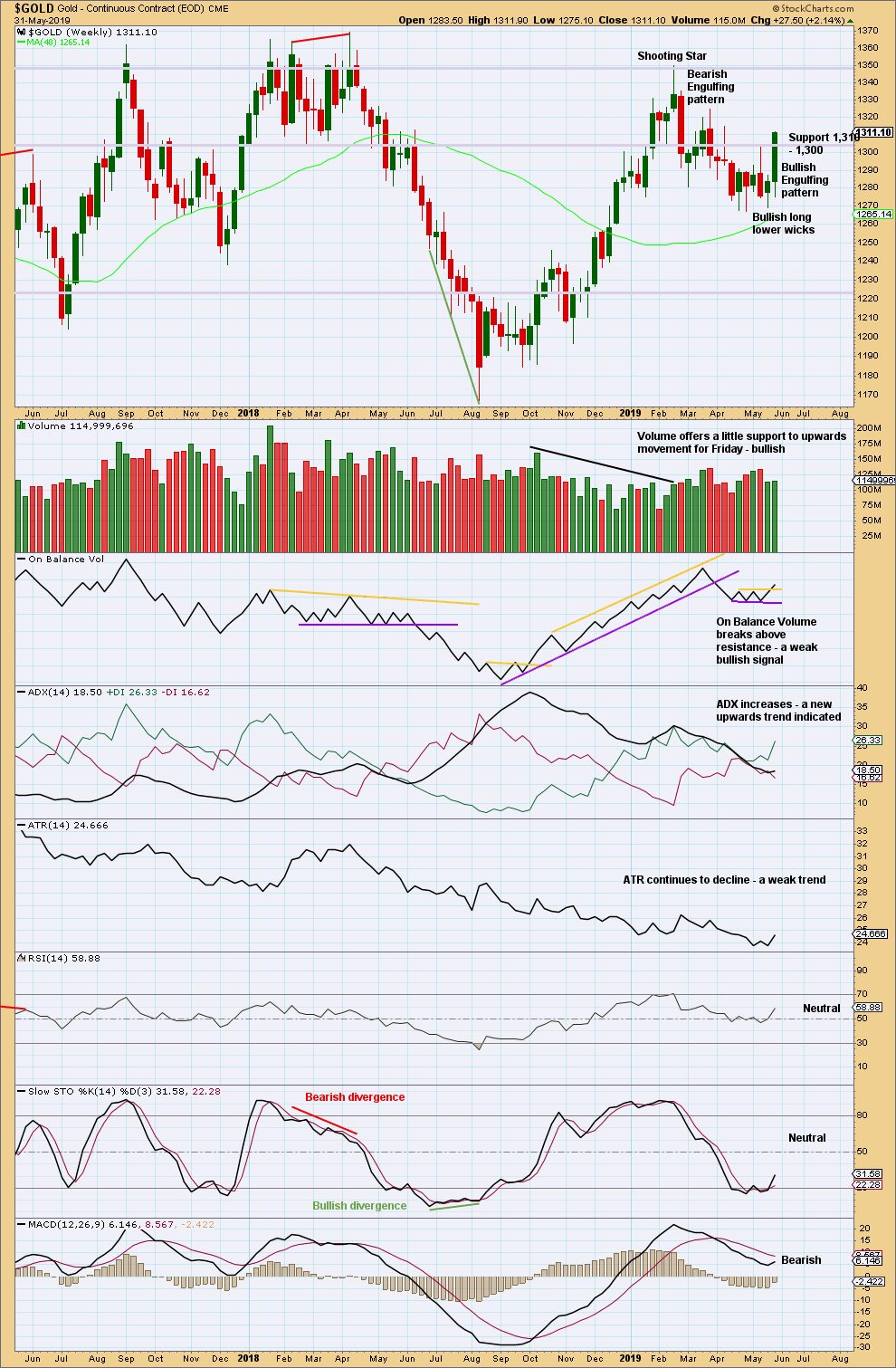
Click chart to enlarge. Chart courtesy of StockCharts.com.
A very strong upwards week with a long lower wick, support from volume and an almost shaven head looks bullish. More upwards movement looks extremely likely next week.
Overall, low and flat to declining ATR now supports both the main Elliott wave count and the double zigzag Elliott wave count.
DAILY CHART
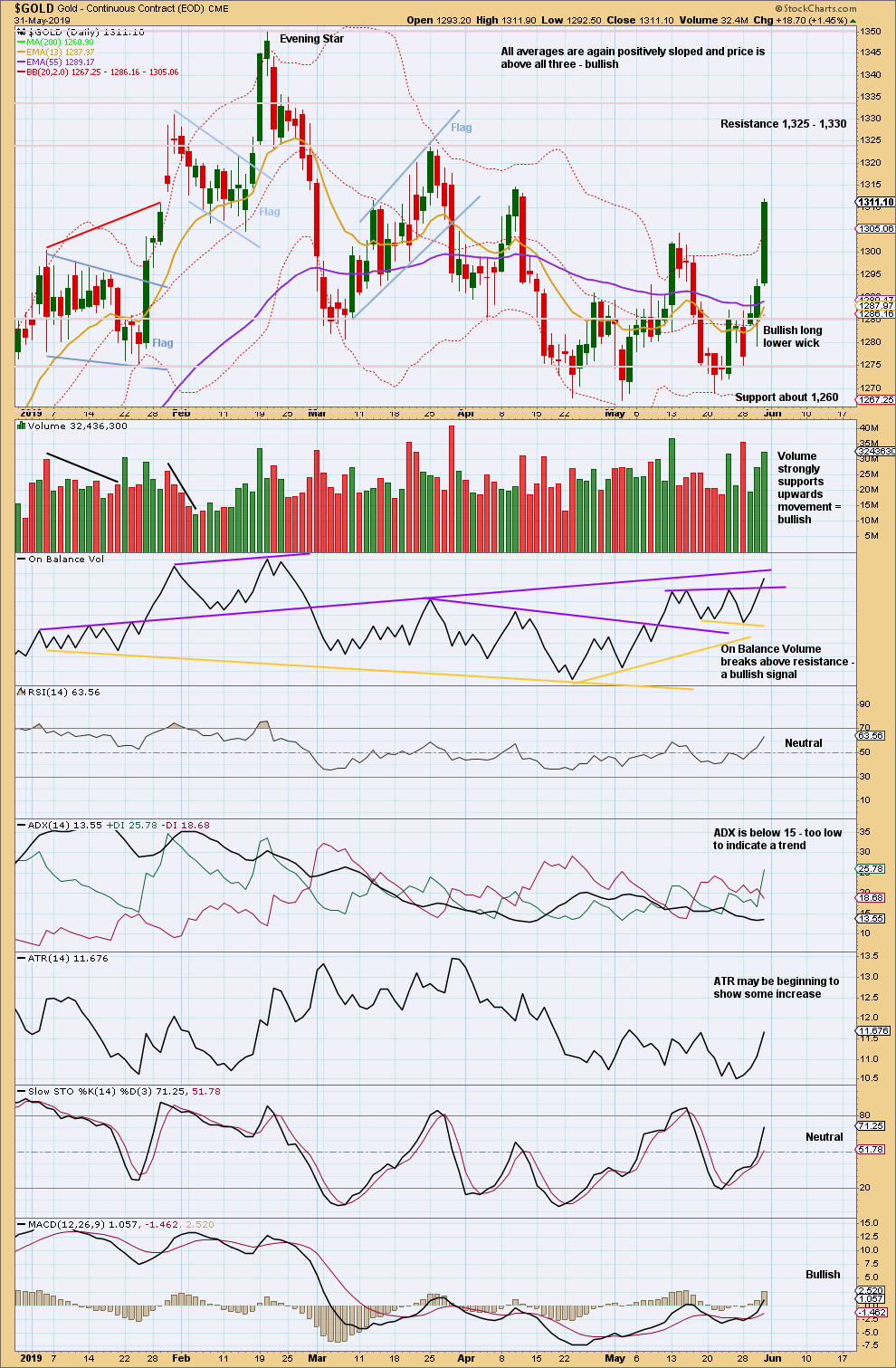
Click chart to enlarge. Chart courtesy of StockCharts.com.
A new swing high above the 14th of May now indicates a potential new upwards trend. ADX does not yet agree, but if it rises to 15 or above, it would then indicate a new upwards trend in the early stages.
A now bullish volume profile and an almost shaven head for Friday’s candlestick strongly suggests more upwards movement next week.
GDX WEEKLY CHART
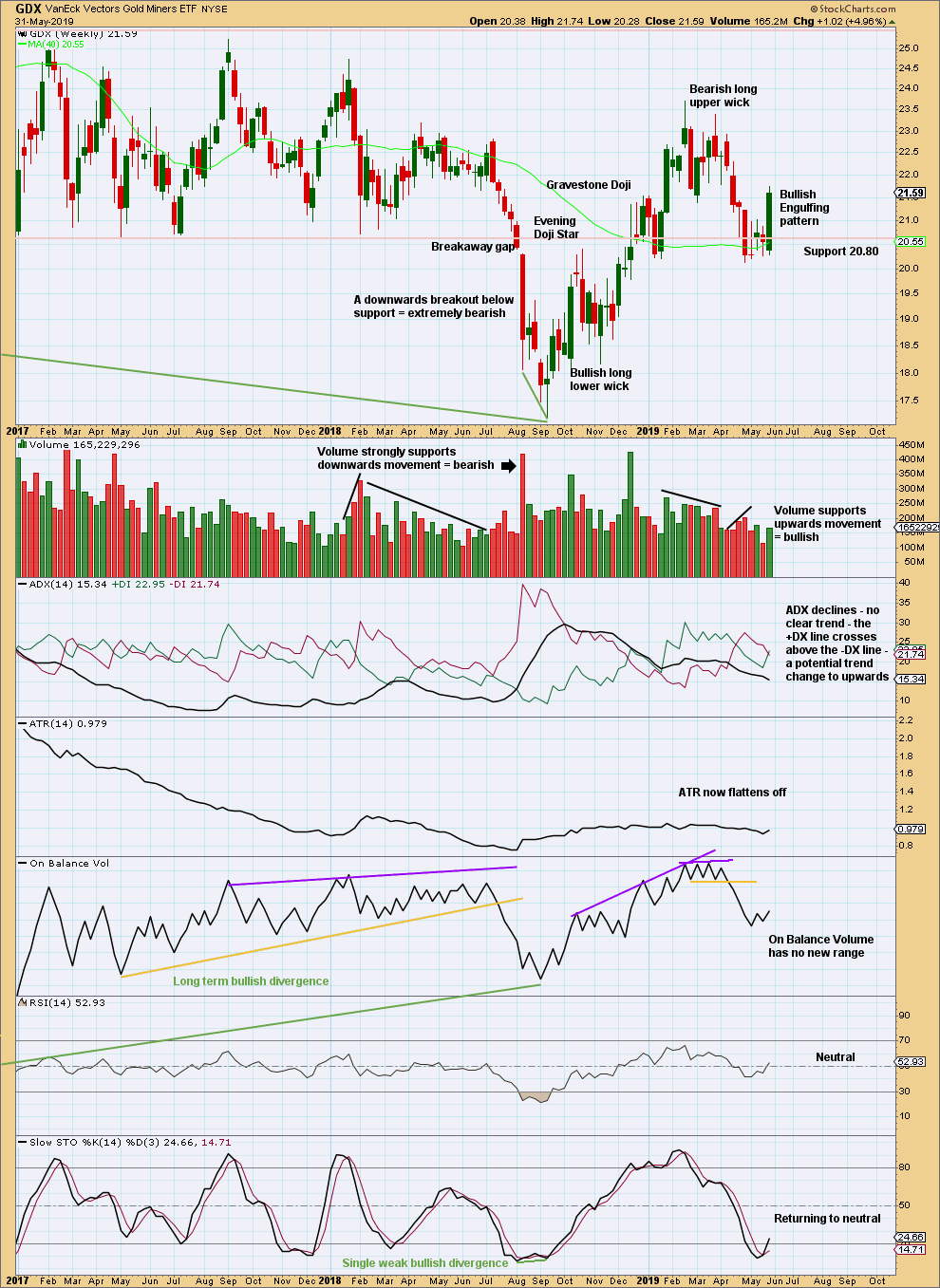
Click chart to enlarge. Chart courtesy of StockCharts.com.
A very strong Bullish Engulfing candlestick pattern, which has support from volume, strongly suggests more upwards movement next week.
GDX DAILY CHART
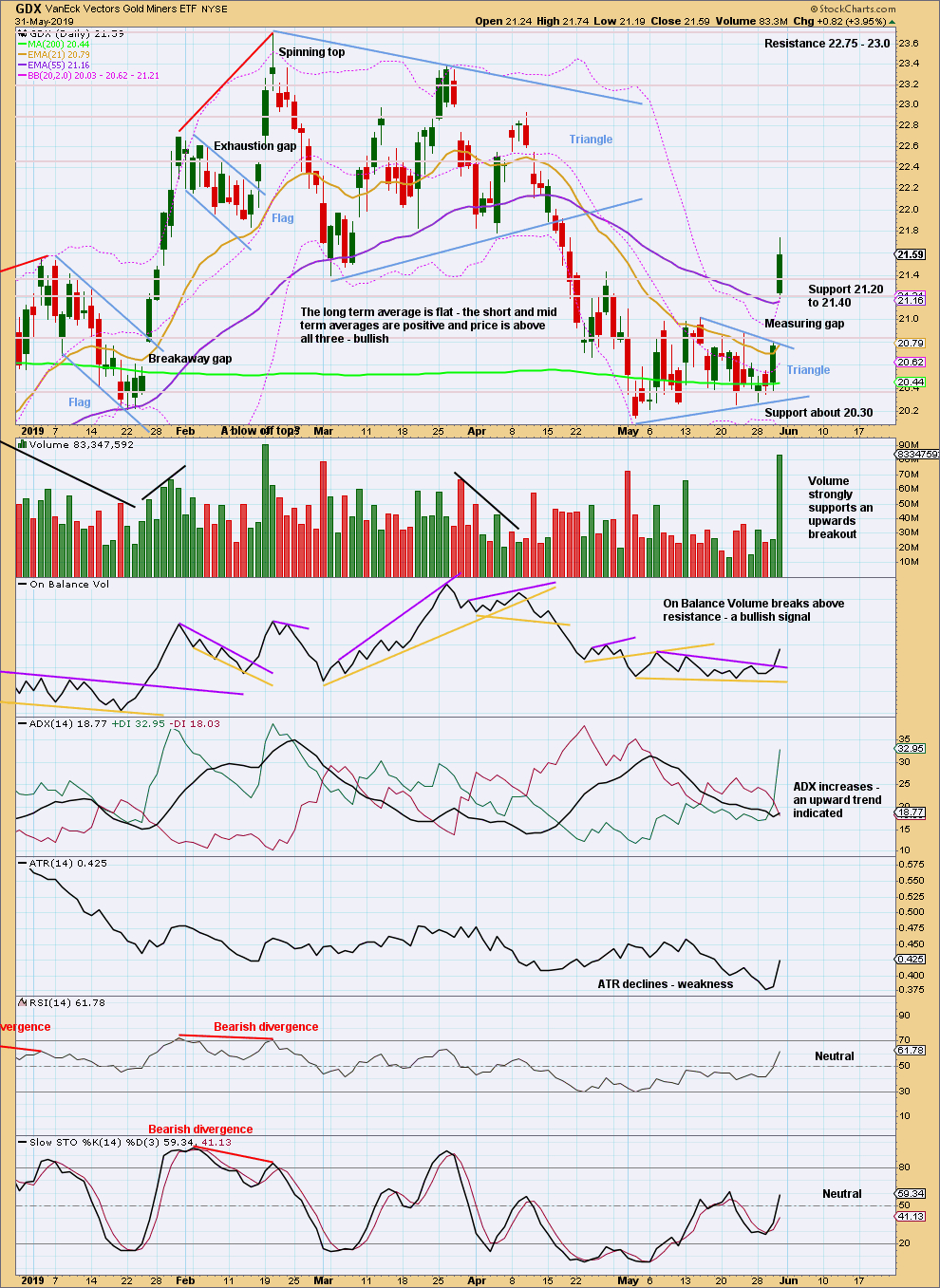
Click chart to enlarge. Chart courtesy of StockCharts.com.
Price has broken out of the triangle upwards. A target calculated using the triangle width is about 21.68, but this has already been met and passed.
A target calculated using the measuring gap is about 21.72, but this too has been met and slightly passed.
The measuring gap may now provide support. It may remain open at 20.81.
Friday looks like a possible blow off top. These are usually followed by some consolidation or a trend change. Here, a consolidation before more upwards movement looks fairly likely.
US OIL
A small bounce to about 61.33 was expected to begin the week, and thereafter downwards movement was expected to continue and to show an increase in momentum. The bounce was more shallow than expected, reaching only to 59.69, but strong downwards movement fits the larger picture exactly.
Summary: The next mid term target is now calculated at 46.66.
The final target is now calculated at 10.72.
MAIN ELLIOTT WAVE COUNT
MONTHLY CHART
The basic Elliott wave structure is five steps forward and three steps back. This Elliott wave count expects that US Oil is still within a three steps back pattern, which began in July 2008. The Elliott wave count expects that the bear market for US Oil continues.
This Elliott wave corrective structure is a double zigzag, which is a fairly common structure. The correction is labelled Super Cycle wave (II).
The first zigzag in the double is complete and labelled cycle wave y. The double is joined by a three in the opposite direction labelled cycle wave x, which subdivides as a zigzag. The second zigzag in the double may now have begun, labelled cycle wave w.
The purpose of a second zigzag in a double zigzag is to deepen the correction when the first zigzag does not move price deep enough. To achieve this purpose cycle wave y may be expected to move reasonably below the end of cycle wave w at 26.06. The target calculated would see this expectation met.
Cycle wave y is expected to subdivide as a zigzag, which subdivides 5-3-5.
Cycle wave w lasted 7.6 years and cycle wave x lasted 2.7 years. Cycle wave y may be expected to last possibly about a Fibonacci 5 or 8 years.
If it continues higher, then primary wave B may not move beyond the start of primary wave A above 76.90.
WEEKLY CHART
This weekly chart is focussed on the start of cycle wave y.
Cycle wave y is expected to subdivide as a zigzag. A zigzag subdivides 5-3-5. Primary wave A must subdivide as a five wave structure if this wave count is correct.
Primary wave A may be a complete five wave impulse at the last low.
Primary wave B may now be a complete single zigzag at the last high.
Primary wave C may have just begun. Primary wave C must subdivide as a five wave structure.
Primary wave A lasted 12 weeks, just one short of a Fibonacci 13.
Primary wave C may be longer in time as well as price. If cycle wave y lasts a Fibonacci 5 years, then primary wave C within it may take as long as a Fibonacci 233 weeks.
Intermediate wave (1) within primary wave C may be subdividing as an impulse. Within the impulse, minor wave 4 may not move into minor wave 1 price territory above 60.04.
Draw a channel about the zigzag of primary wave y using Elliott’s technique for a correction. Draw the first trend line from the start of primary wave A to the end of primary wave B, then place a parallel copy on the end of primary wave A. The upper edge of this channel may show where bounces along the way down find resistance. The lower edge of the channel may provide support.
DAILY CHART
Note that monthly and weekly charts are on a semi-log scale, but this daily chart is on an arithmetic scale. This makes a slight difference to trend channels.
Primary wave C must subdivide as a five wave structure, most likely an impulse. Within the impulse, minor waves 1 and now 2 may be complete. The target calculated last week for minor wave 3 to reach 1.618 the length of minor wave 1 at 53.21 has been met and passed and the structure of minor wave 3 looks incomplete. A new target is calculated for minor wave 3 to end using the next Fibonacci ratio in the sequence.
Minor wave 3 may only subdivide as an impulse. Within the impulse, minute wave iv may not move into minute wave i price territory above 57.33.
TECHNICAL ANALYSIS
MONTHLY CHART
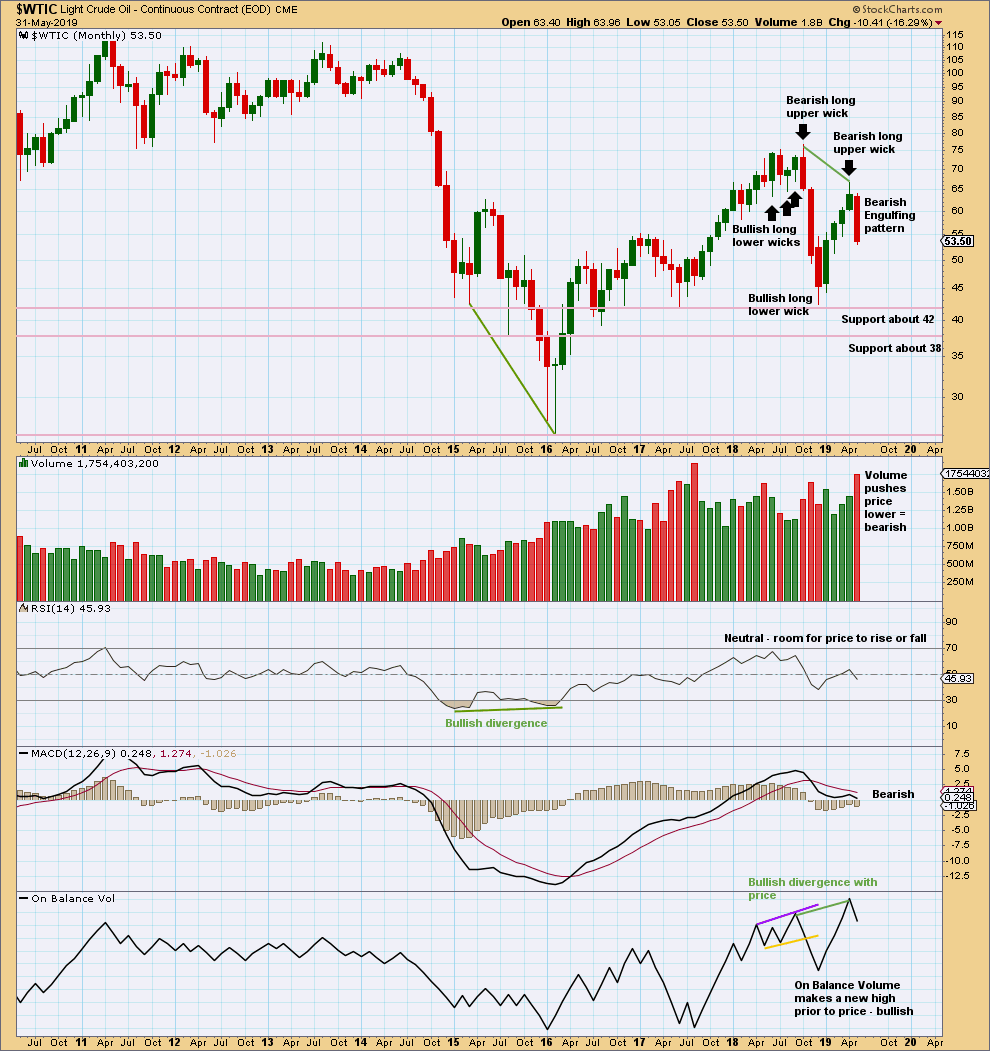
Click chart to enlarge. Chart courtesy of StockCharts.com.
May has closed with a strong Bearish Engulfing candlestick pattern, which has strong support from volume. This supports the Elliott wave count.
WEEKLY CHART
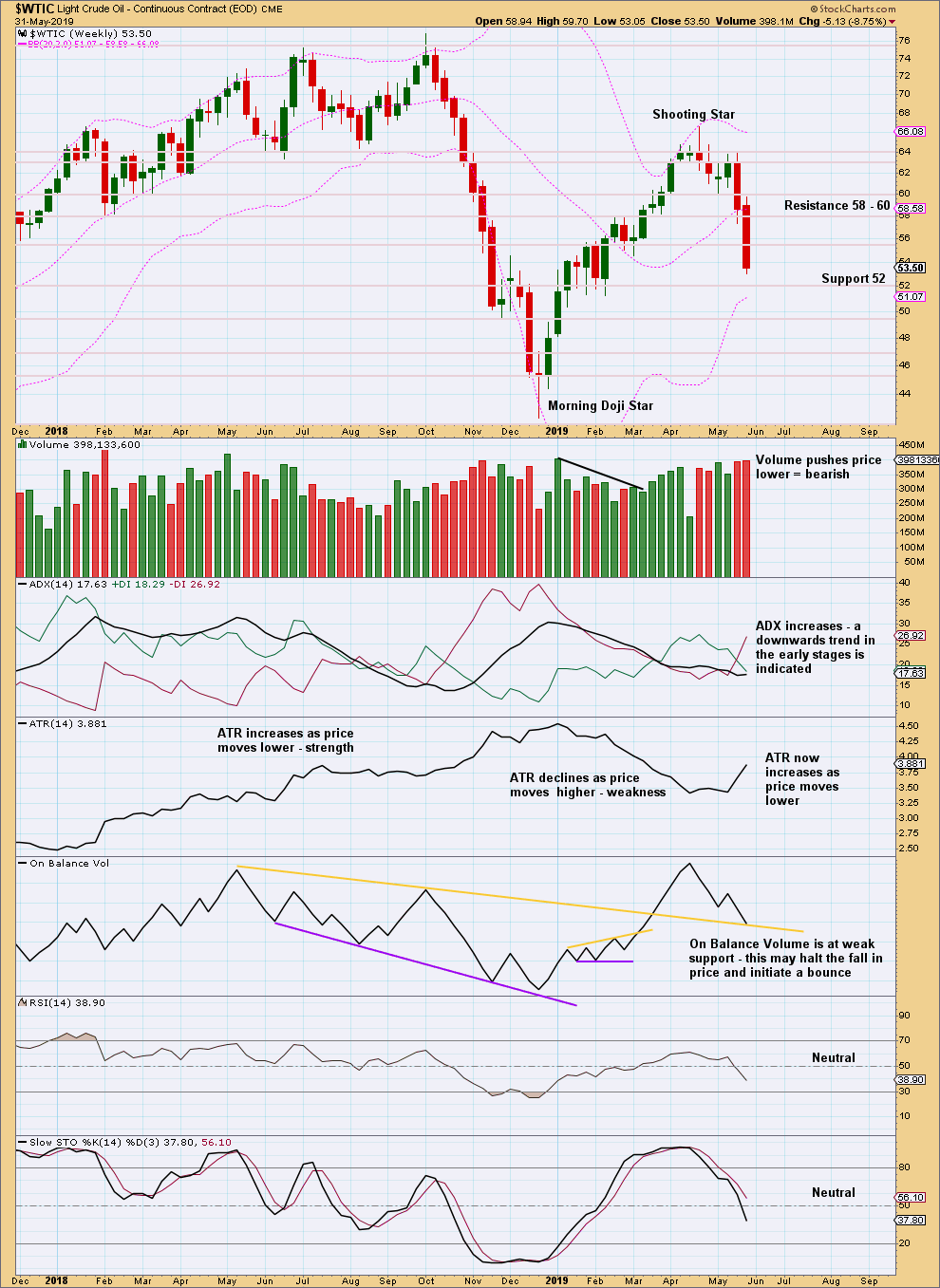
Click chart to enlarge. Chart courtesy of StockCharts.com.
This chart remains bearish and supports the Elliott wave count.
Support on On Balance Volume is weak. It may not halt a fall in price.
DAILY CHART
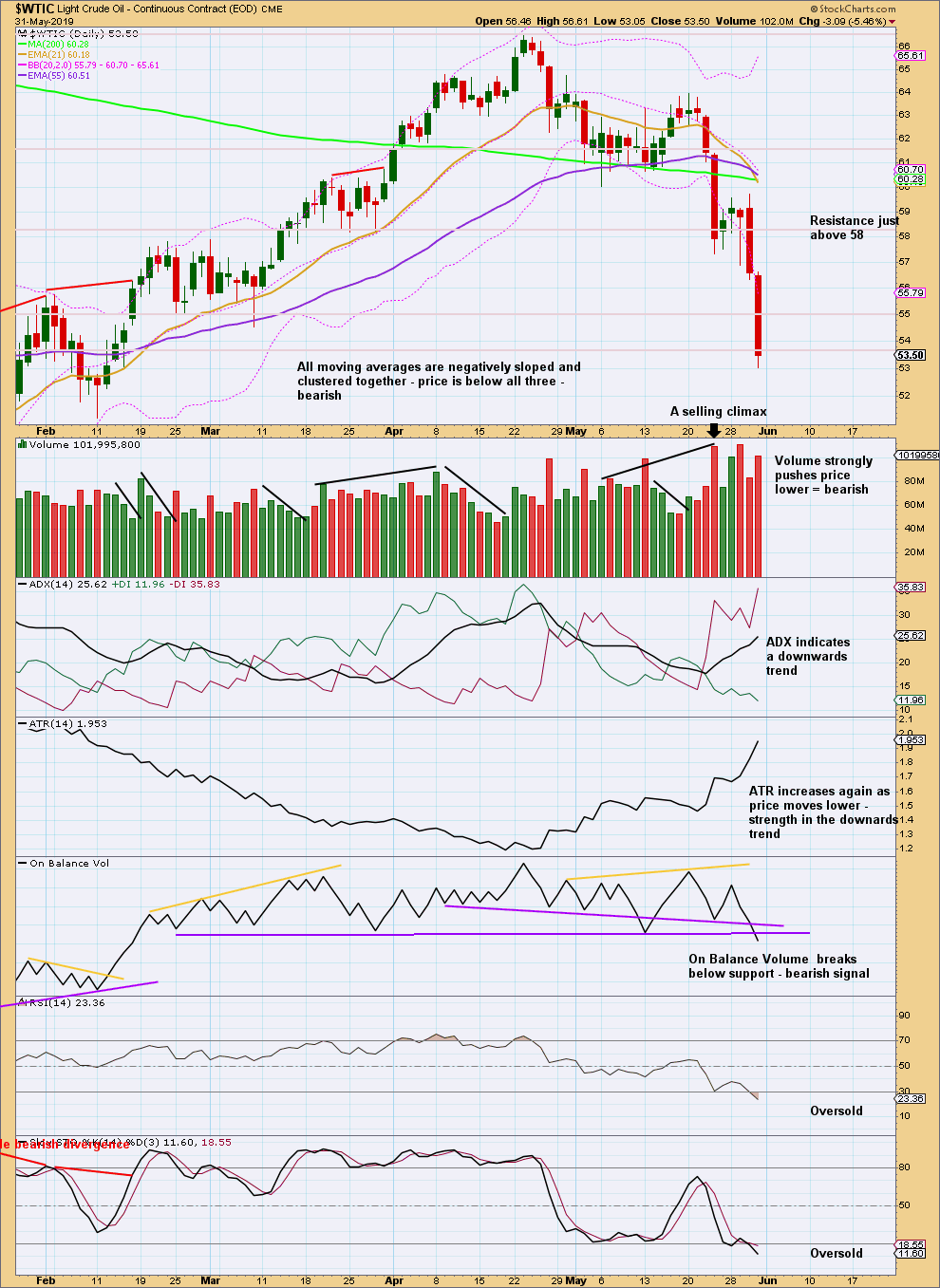
Click chart to enlarge. Chart courtesy of StockCharts.com.
The downwards trend has strength.
Stochastics may remain oversold for a reasonable period of time when Oil trends strongly. Only when it has been oversold for a while and then exhibits bullish divergence with price would it be indicating an end to the downwards trend.
Likewise, RSI may also remain extreme for reasonable periods of time when Oil trends. Bullish divergence would indicate a possible end to the trend. That is not evident yet.
—
Always practice good risk management as the most important aspect of trading. Always trade with stops and invest only 1-5% of equity on any one trade. Failure to manage risk is the most common mistake new traders make.

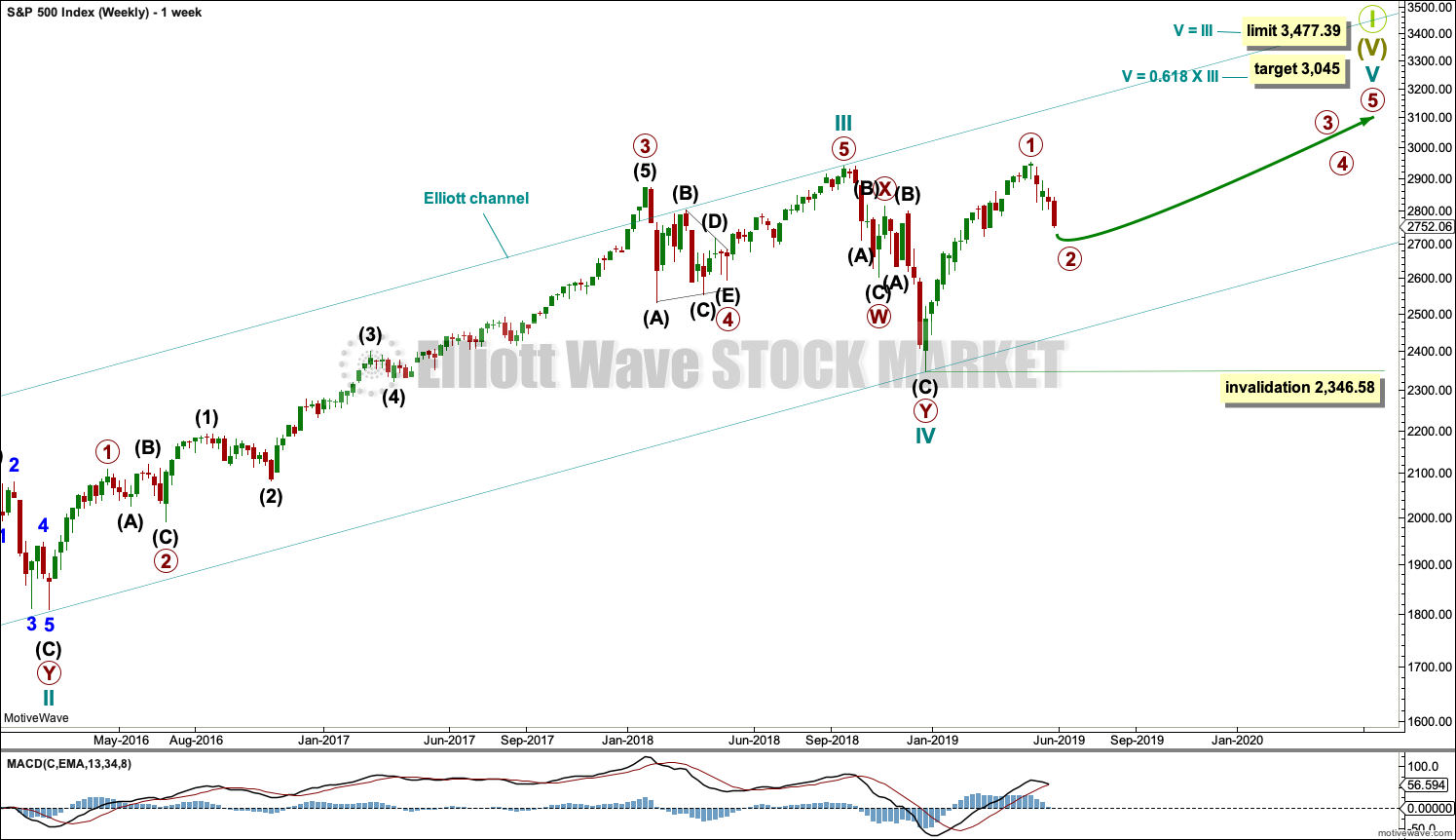
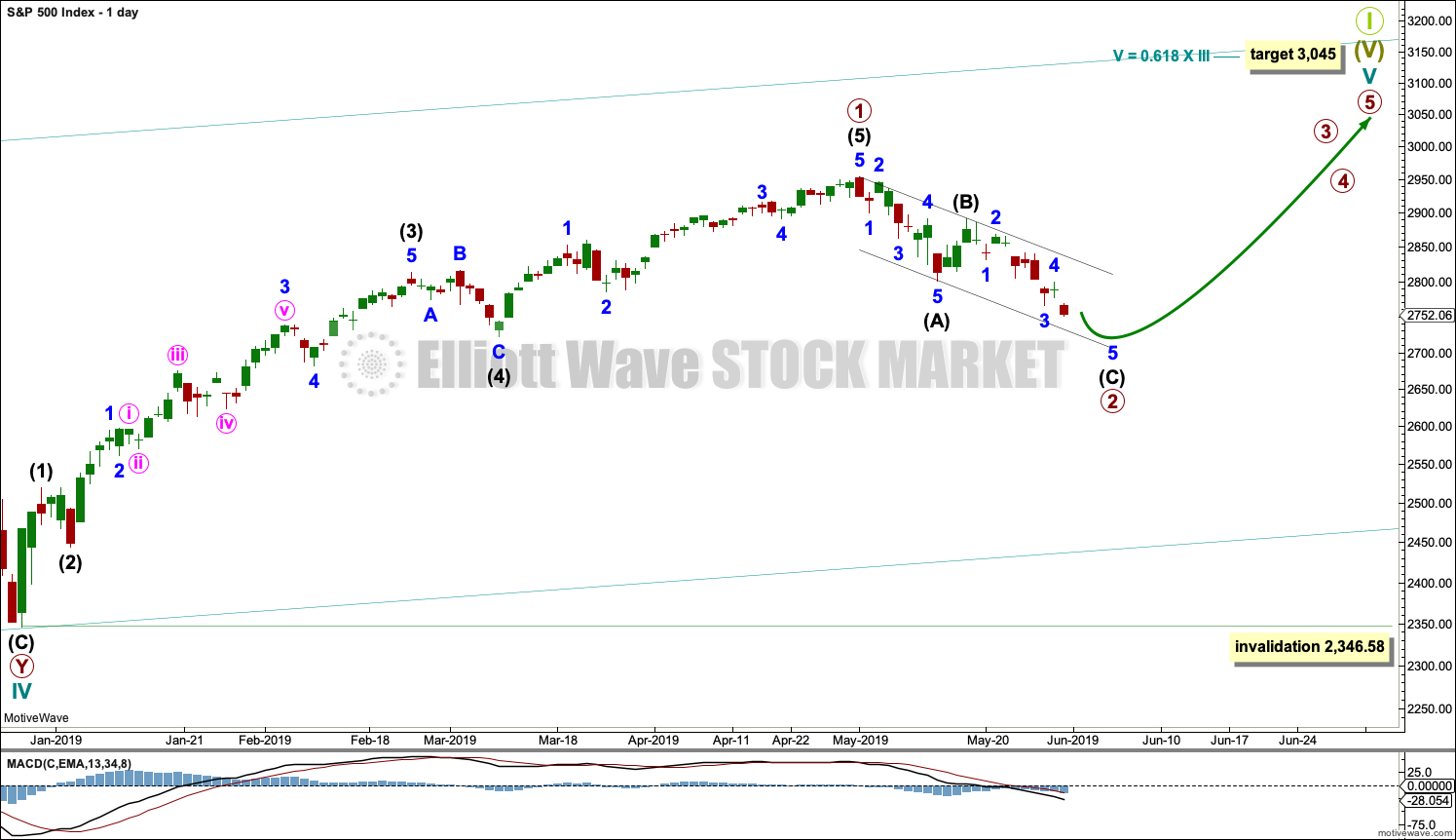
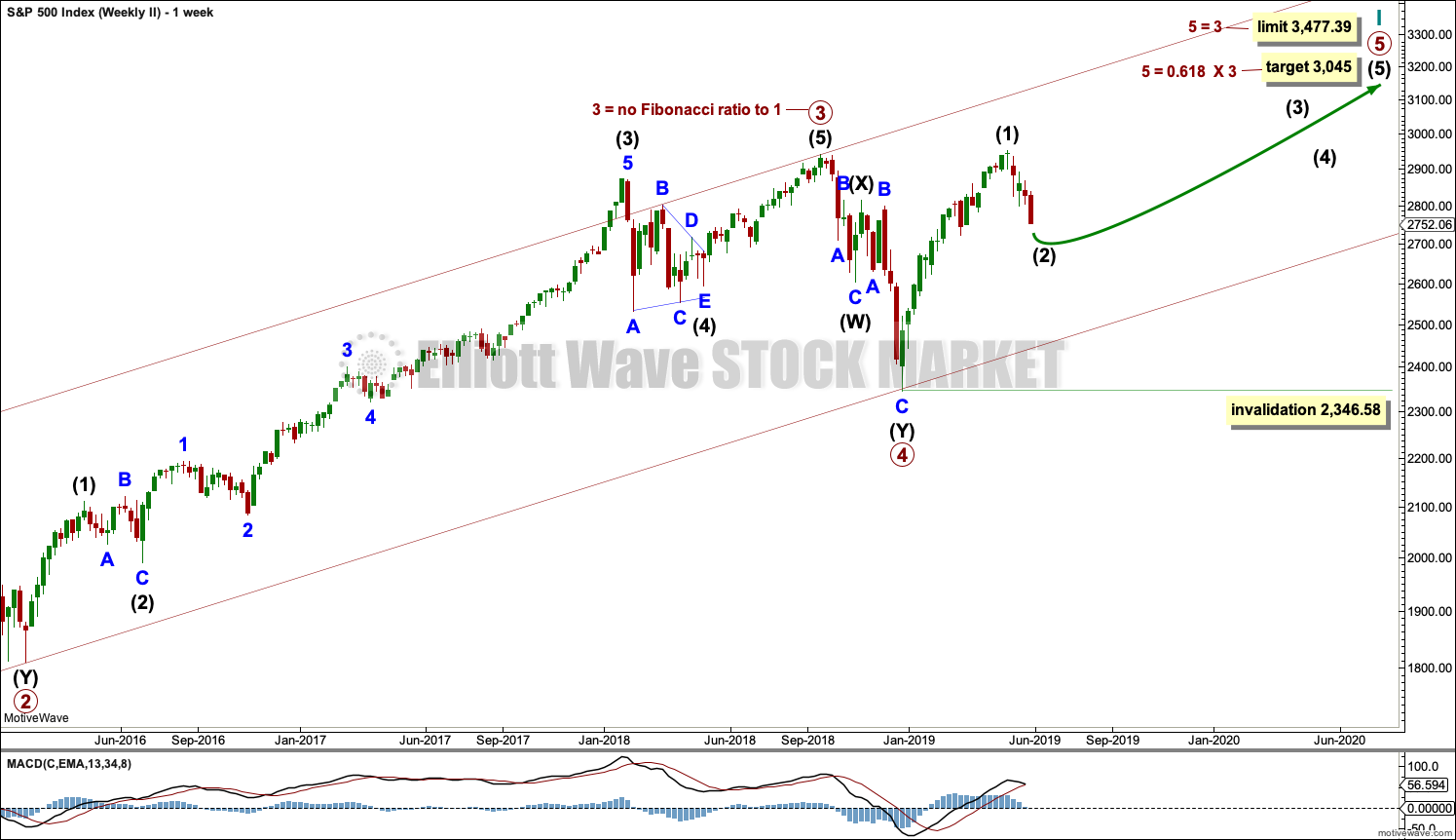
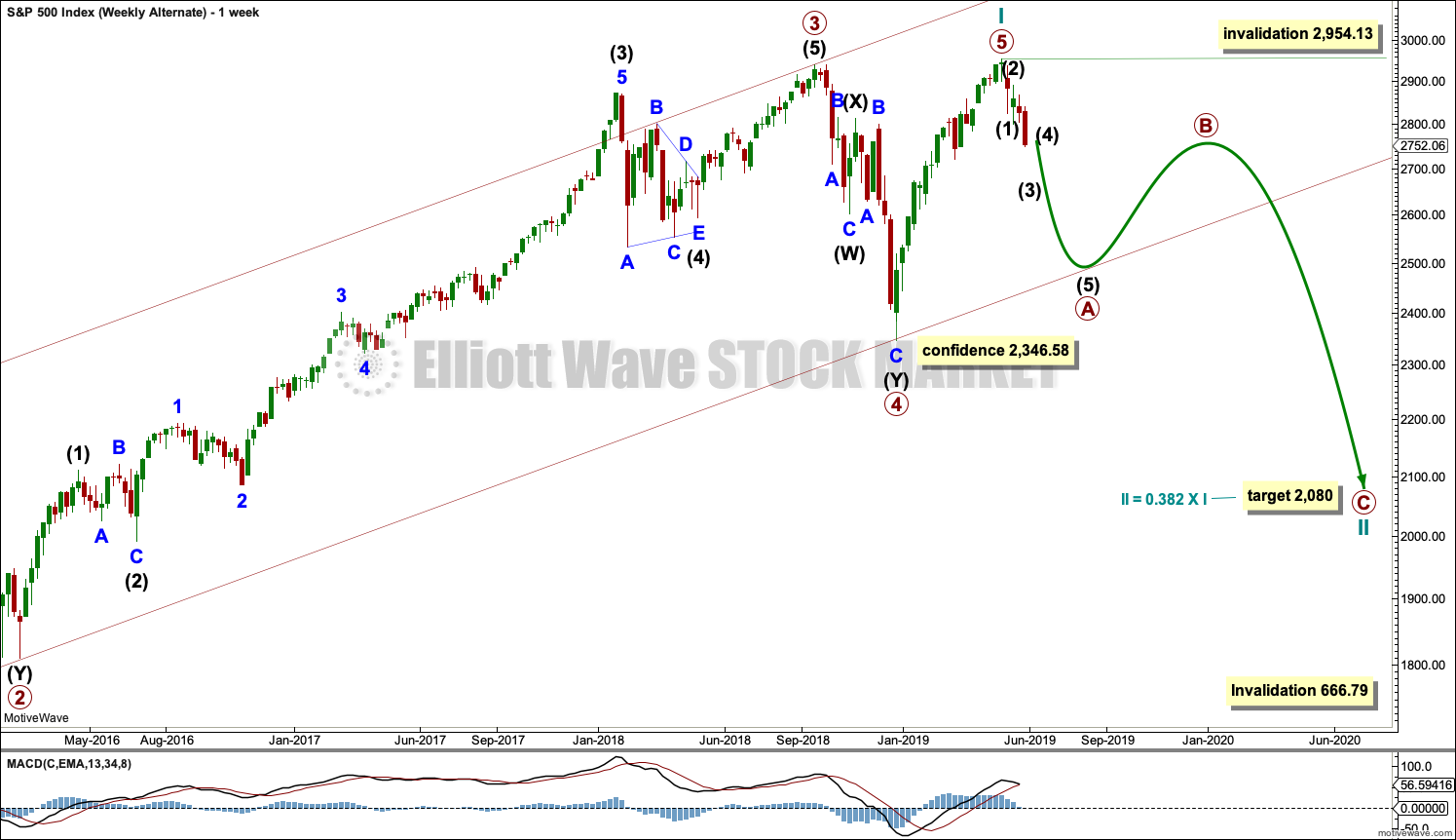
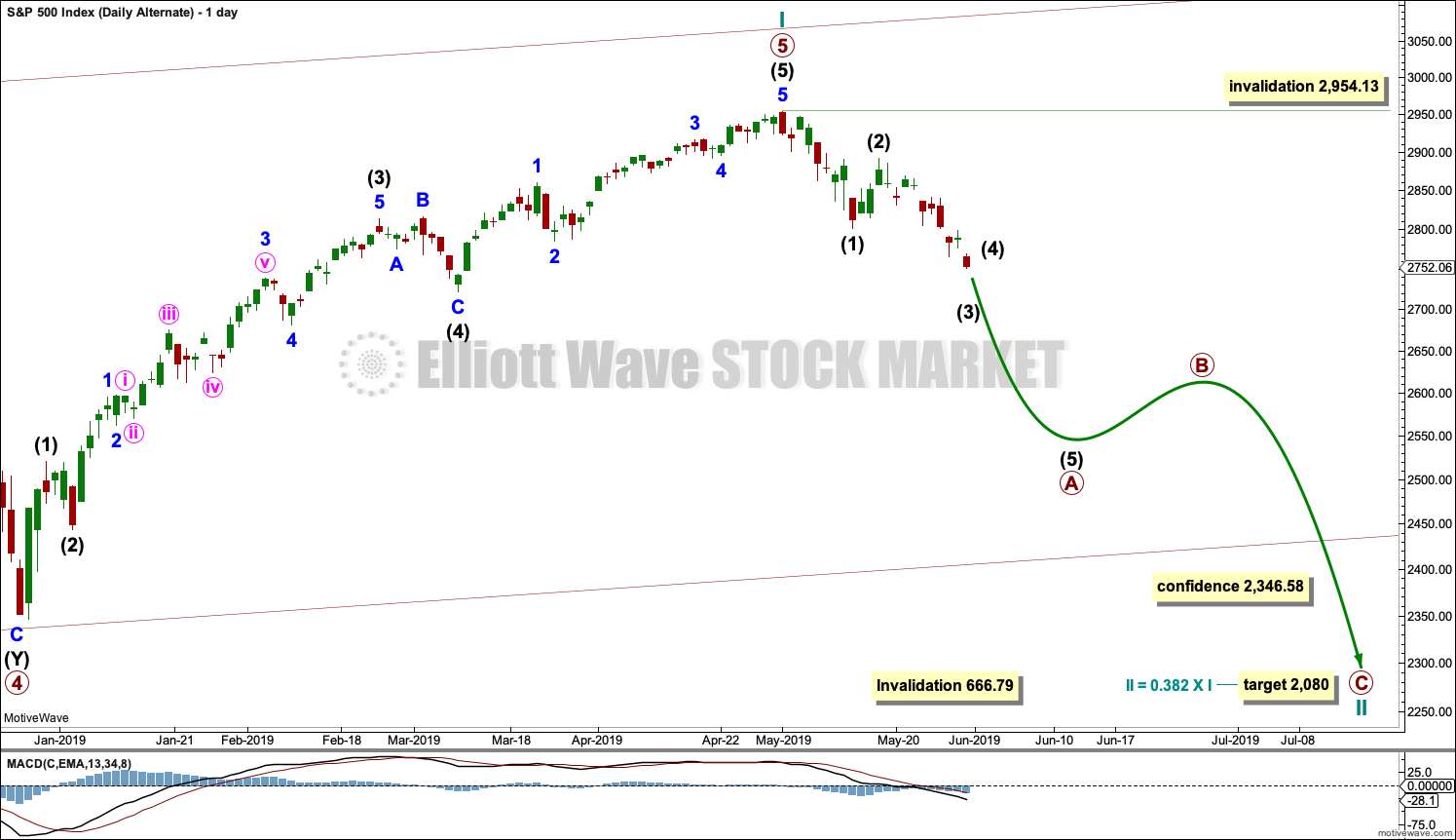
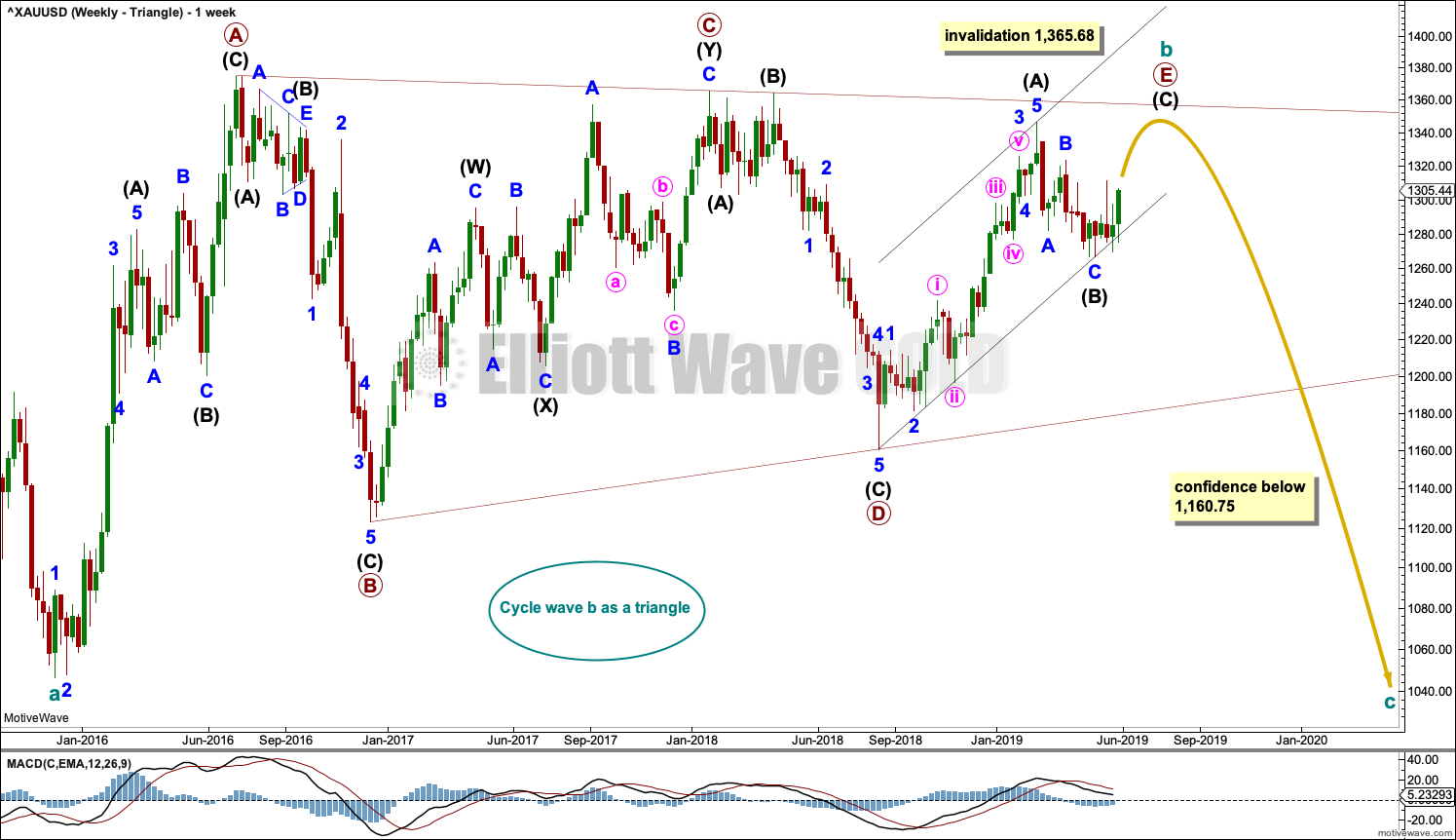
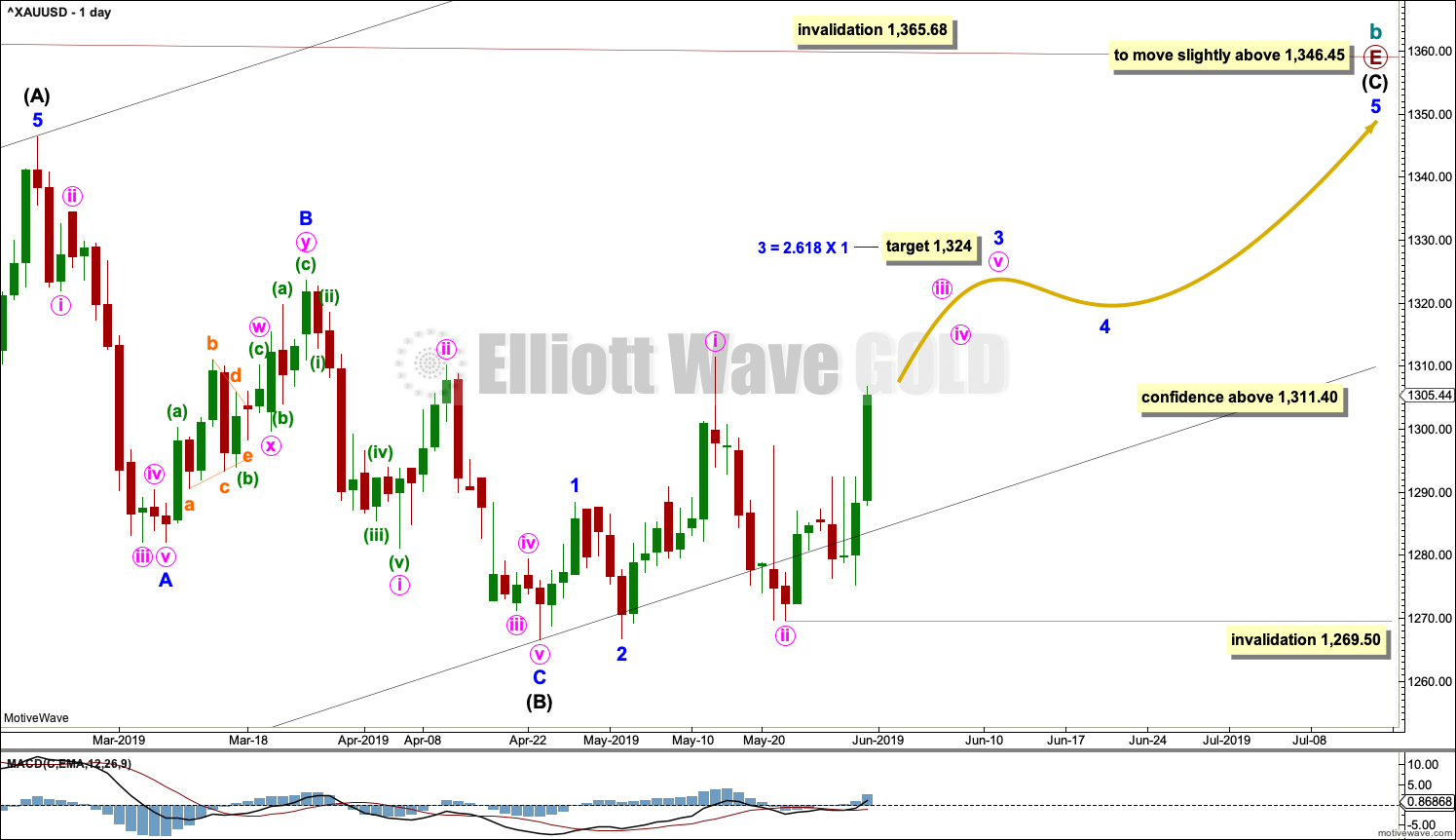
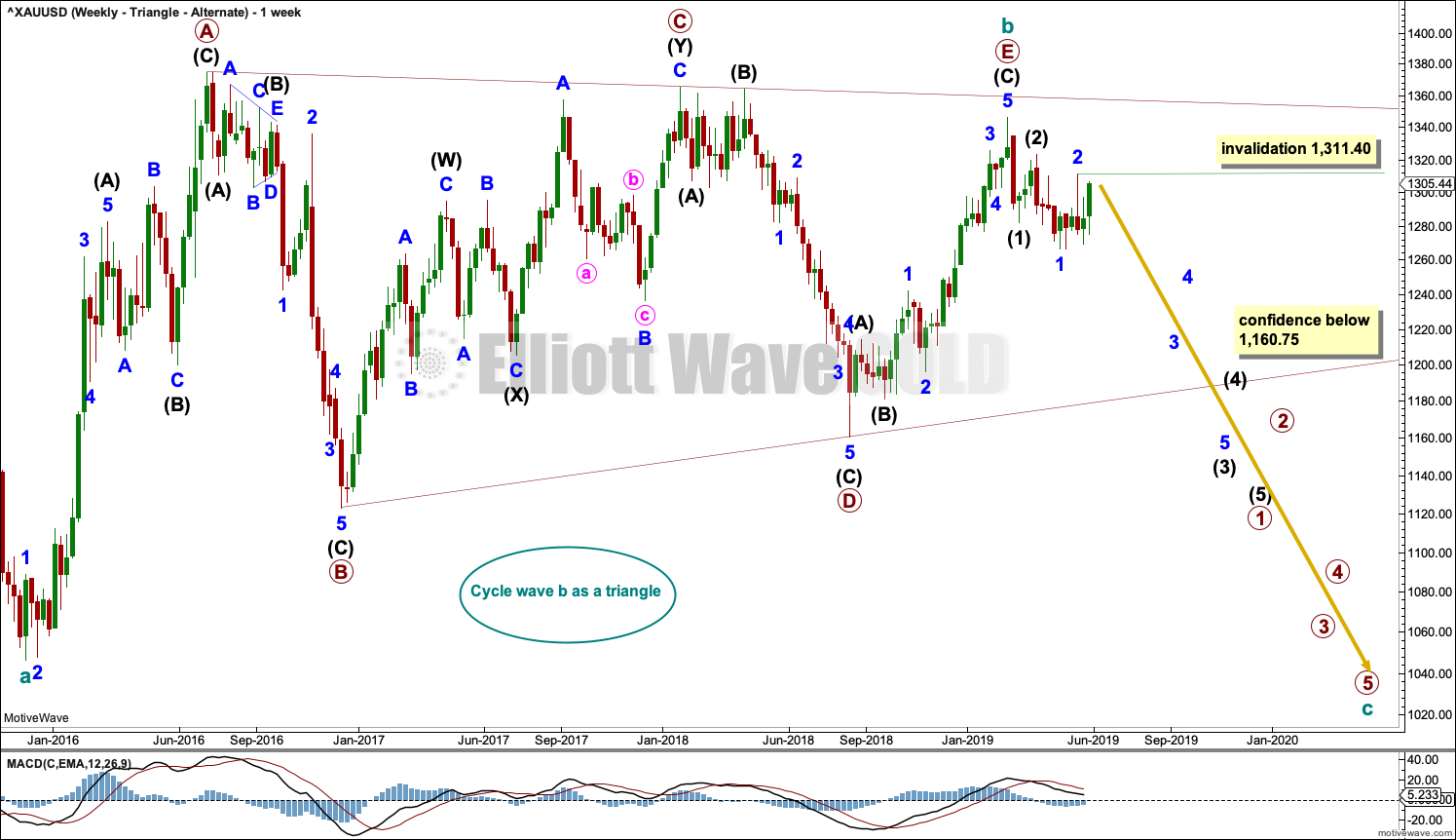
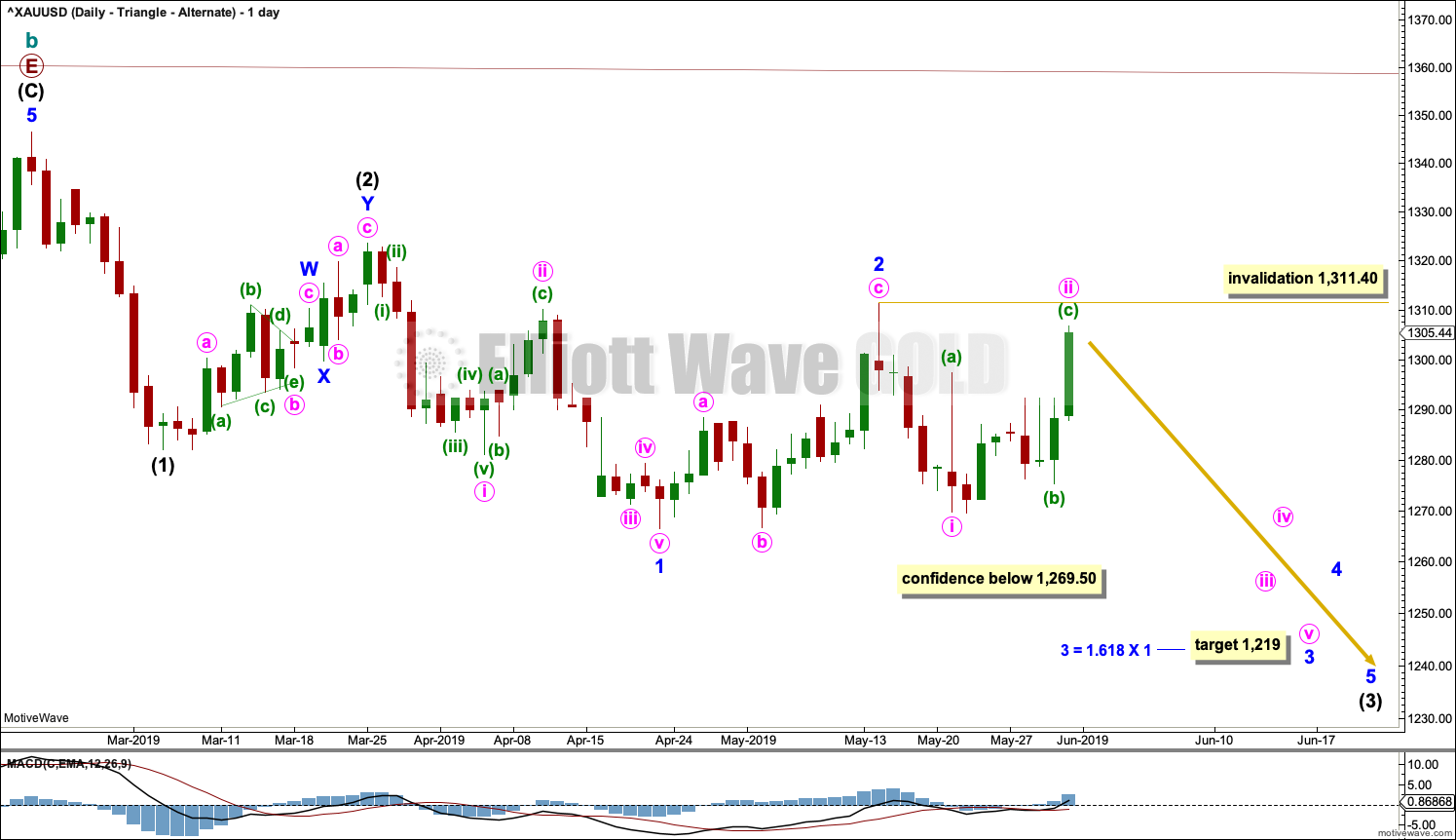
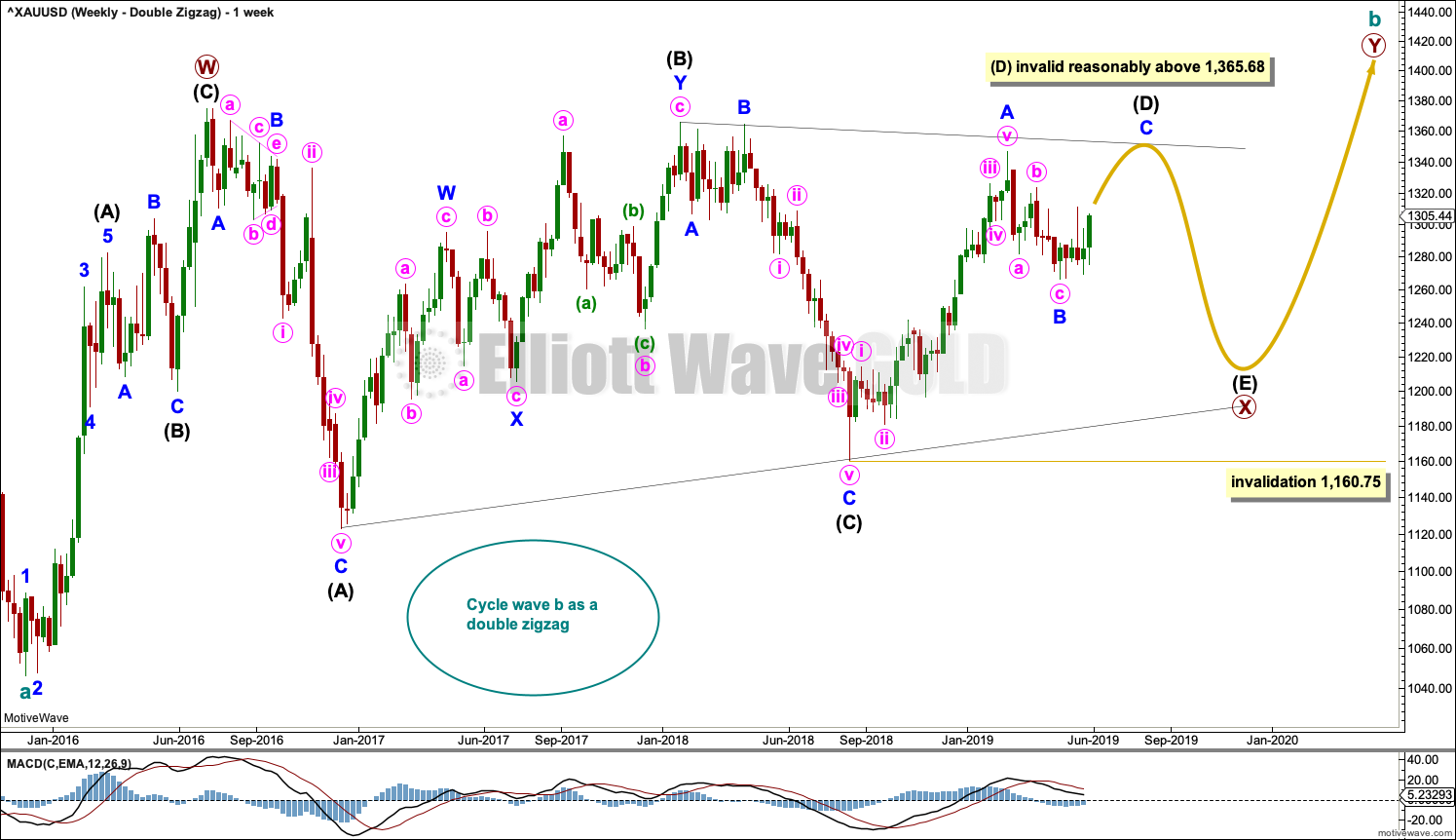
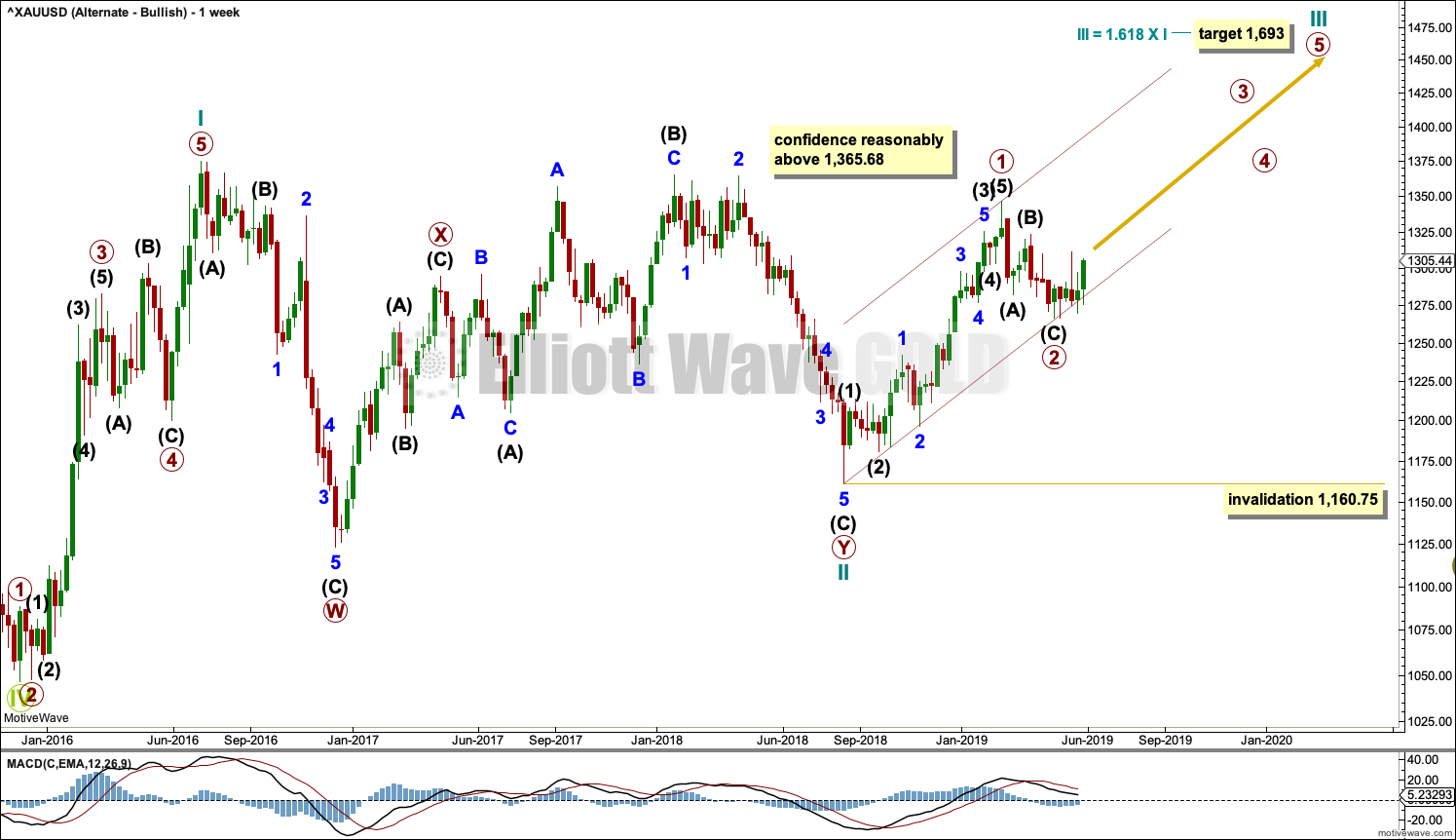
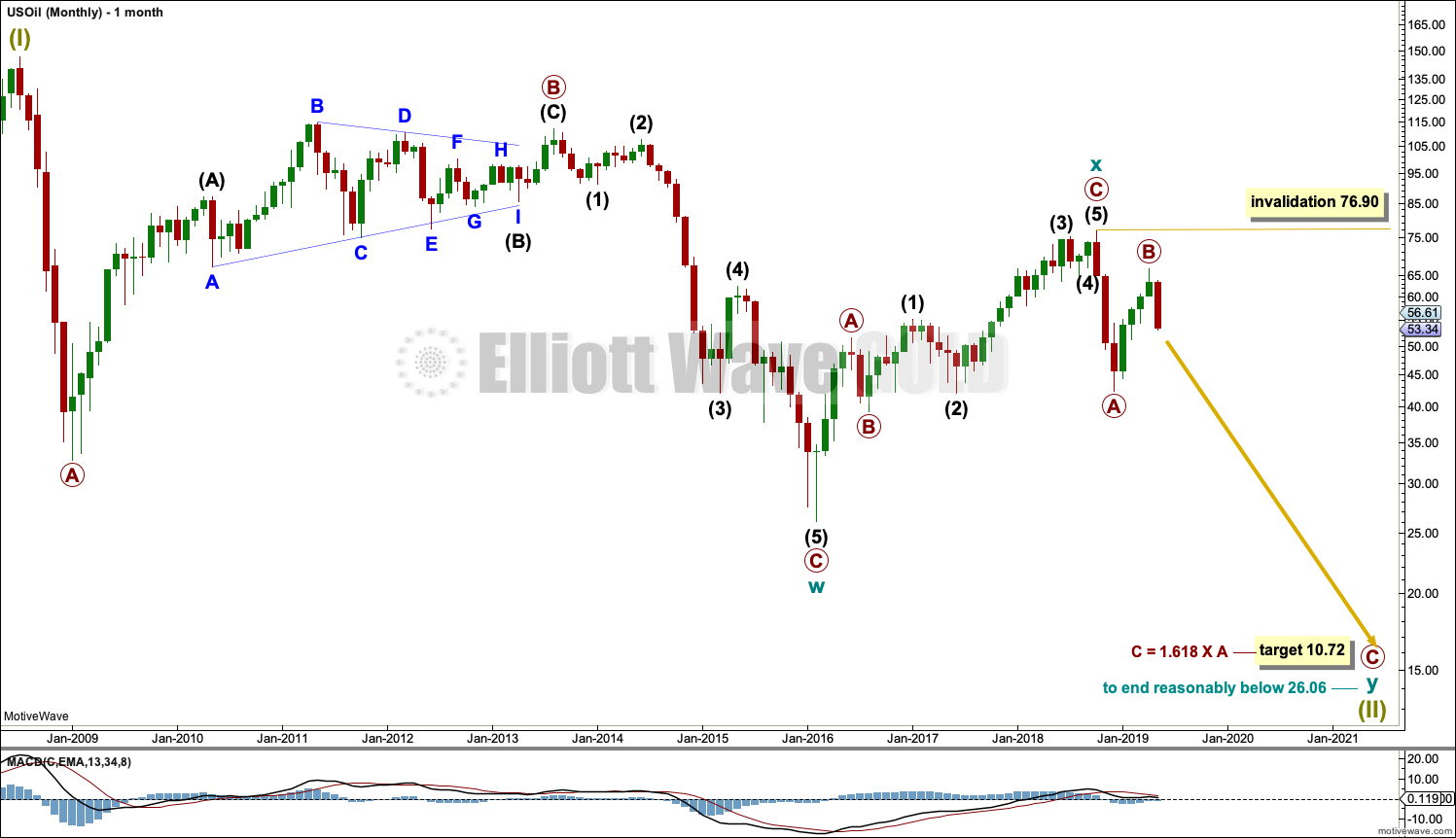

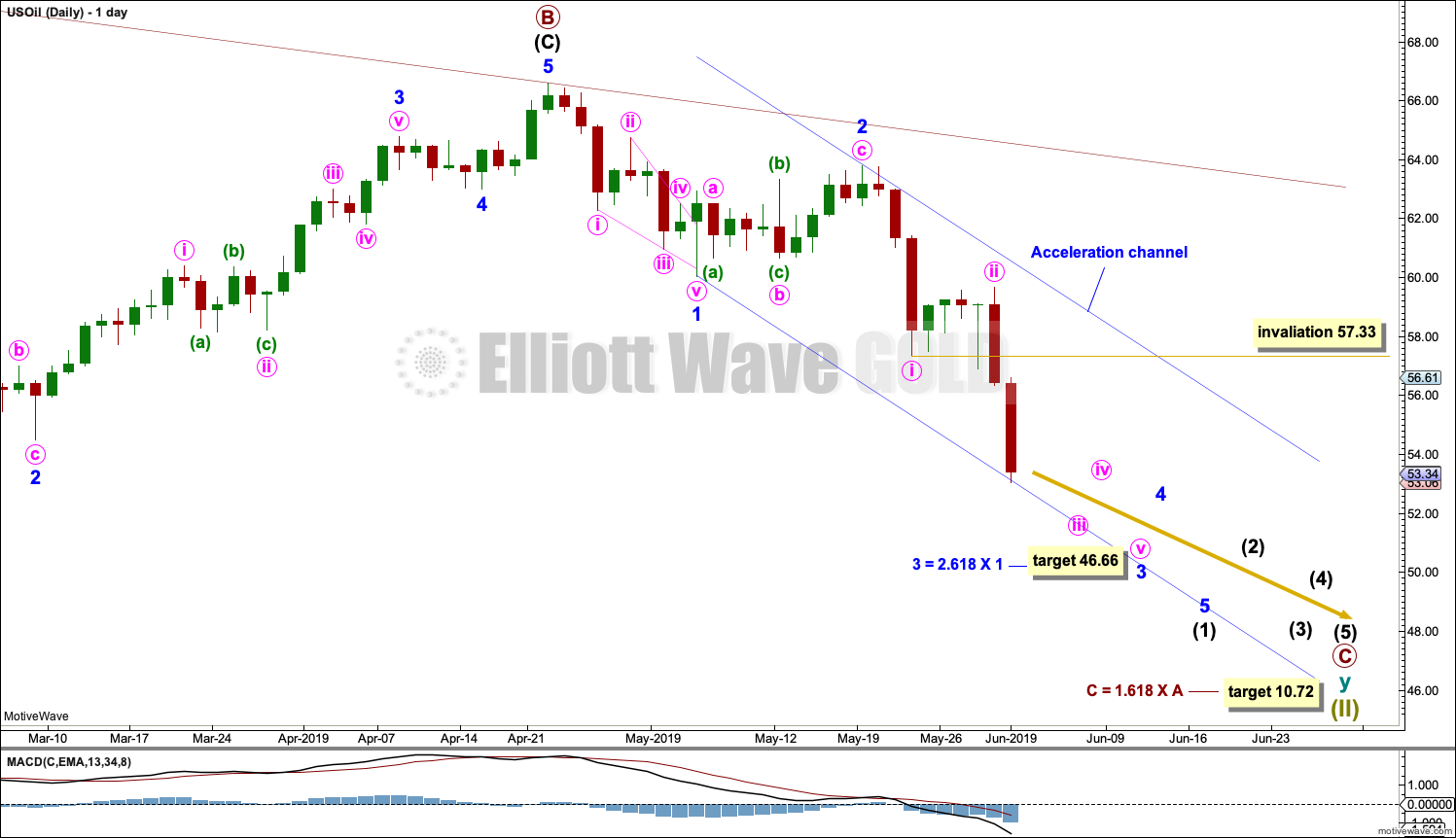
FYI everybody, I’ve finally finished my charts for an updated USD index analysis. Will be published over the weekend. Apologies for the long delay and thank you all for your patience.
It wasn’t easy, and had me a bit stumped for just a couple of hours. That rarely happens.
Gold is following a blow off top pattern that I follow. The inside day yesterday was the first part. Second part is if we get a new high today, but does not go below the low of yesterday (yet). The new low below yesterday’s inside day low needs to come next week either Mon/Tues/Wed. A reversal outside day today would also count, preferably with a new high above 1346.
Alternatively, gold/silver are off to the races this year! Clear as mud!
Strength in gold stocks recently is something to watch.
Certainly looks like stocks are off to the races and are heading to new highs. I’ve decided to start a short selling program in gold again to take advantage of this potential fake out move to the upside… could be a swift move down from here. Of course any sustained move above 1365 for gold then I will rethink the short position.
Watching this action in the market this morning makes me believe we’re going to go to a lower target possibly below 2700. More of a gut feel on that one. I am now flat gold after a nice run up with my long positions … It makes complete sense to sit on the sidelines as we test 1346 to 1365… if there’s a break-out over 1365 and silver continues to look strong then I’ll re-enter long. However, part of me still believes that we are going into a deflation cycle and leveraging in the metal space will lead to lower prices. I could be totally wrong and if we go up above 1365 then we might be off to the races on the upside.
This last wave up is either a final “C” wave or the start of a third wave up. C waves can be real feakout waves because they tend to be strong and fast. The problem with gold is if this is not a third wave up, then we are going into another big C wave down. Hense, why I’ll wait.
Corey
To clarify my comments on the S&P 500… I think we go below the recent lows before we go on to make new highs.
Thank you for your post Corey. Just before market close I came up with 2690 as target for S&P.
I was also looking at DUST as a bullish divergent bar. After inspection we may just move back inside the lower bollinger band.
I’m finding the markets to be potentially at an inflection point. I’ll be very interested in seeing if the market can rally to new highs and also see if gold can continue this move up. I think there’s a chance that instead of gold turning back down in the face of market strength, that we might be able to get a rally in both markets and that gold will be a leading indicator for the future of the market…i.e. we are a few months away from a top in stocks and gold will lead. Just some thoughts.
Also, re-entered my long gold position for another run to 1346.
Quick update for the S&P:
Today the AD line gives a sharp day of single day bullish divergence and Lowry’s data shows up volume dominated today at 72%, and advances dominated at 65%.
The first target was met, the second target not quite yet.
I will today make a tentative call that a low may be in place here. Confidence may be had
1. above 2,799
2. with a breach of the parallel channel by upwards movement
3. strong confidence above 2,892.15 (where the bearish alternate will be discarded)
If price keeps falling then use target as already given; next 2,722 then 2,690 (which still looks too low)
The info about the AD line and Lowry’s is what the McClellan Oscillator was telling me yesterday. It was up while SPX price was down. Furthermore, it has not made a new low below the May 13th low while price has certainly done so. I think your tentative call of a low in place has a very high probability of being correct. If not, the next two targets are relatively close by.
Thus I went 33% long yesterday and will add another 33% or more today (most likely).
Fantastic Rodney! Now…. if this upwards movement continues and shows strength, it would support the wave count. Today was almost a 90% up day, it was 89%. So close. Quite strong… so far.
Hi Lara,
I am starting to believe more in your above count than the more bullish one as the QQQ:SPX had a short term break down… However, not a complete break down….
I think, at the end of the SPX primary wave 3, I will take some profits…
The US 10 year yield is very weak.
Interesting developments.
Mathieu
Powerful rally in gold today. Wow! Looks like we are moving up and tracking the current wave count. Thanks Lara, it is only due to your comments intra-week last week that I exited my handsomely profitable gold short positions just in the nick of time.
Whew! I’m glad they were profitable and you didn’t lose the profit.